Review of the Copenhagen Climate Change Conference and Negotiations
VerifiedAdded on 2022/11/29
|27
|15145
|110
Report
AI Summary
This report provides an in-depth analysis of the 2009 Copenhagen Climate Change Conference from the perspective of a government delegate. It details the complex political dynamics, key policy issues, and the positions of major countries and coalitions during the UN climate negotiations. The report offers an insider's account of the heated debates and the dramatic collapse of the conference, highlighting the failure to produce a global climate treaty. It contrasts the stagnation of the UN process with the progress in aggregate climate policy and multilevel climate governance. The report also examines the background and context of the conference, the stakes involved, the consequences of climate change, and the policy ramifications. It concludes by assessing the outcomes of Copenhagen, identifying policy achievements and failures, and evaluating the current state of global climate politics.
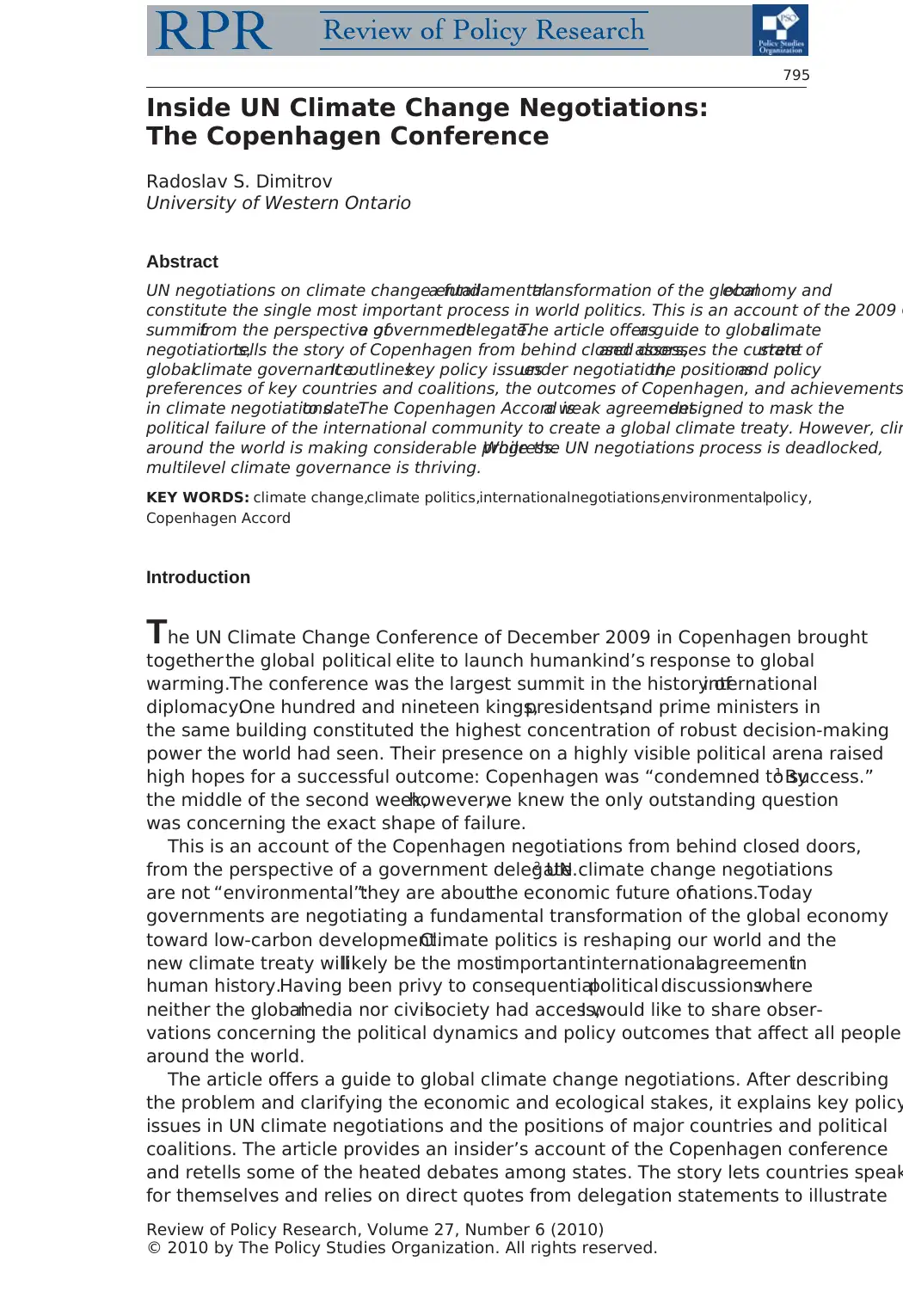
Inside UN Climate Change Negotiations:
The Copenhagen Conferenceropr_472 795..822
Radoslav S. Dimitrov
University of Western Ontario
Abstract
UN negotiations on climate change entaila fundamentaltransformation of the globaleconomy and
constitute the single most important process in world politics. This is an account of the 2009 C
summitfrom the perspective ofa governmentdelegate.The article offersa guide to globalclimate
negotiations,tells the story of Copenhagen from behind closed doors,and assesses the currentstate of
globalclimate governance.It outlineskey policy issuesunder negotiation,the positionsand policy
preferences of key countries and coalitions, the outcomes of Copenhagen, and achievements
in climate negotiationsto date.The Copenhagen Accord isa weak agreementdesigned to mask the
political failure of the international community to create a global climate treaty. However, clim
around the world is making considerable progress.While the UN negotiations process is deadlocked,
multilevel climate governance is thriving.
KEY WORDS: climate change,climate politics,internationalnegotiations,environmentalpolicy,
Copenhagen Accord
Introduction
The UN Climate Change Conference of December 2009 in Copenhagen brought
togetherthe global political elite to launch humankind’s response to global
warming.The conference was the largest summit in the history ofinternational
diplomacy.One hundred and nineteen kings,presidents,and prime ministers in
the same building constituted the highest concentration of robust decision-making
power the world had seen. Their presence on a highly visible political arena raised
high hopes for a successful outcome: Copenhagen was “condemned to success.”1 By
the middle of the second week,however,we knew the only outstanding question
was concerning the exact shape of failure.
This is an account of the Copenhagen negotiations from behind closed doors,
from the perspective of a government delegate.2 UN climate change negotiations
are not “environmental”:they are aboutthe economic future ofnations.Today
governments are negotiating a fundamental transformation of the global economy
toward low-carbon development.Climate politics is reshaping our world and the
new climate treaty willlikely be the mostimportantinternationalagreementin
human history.Having been privy to consequentialpolitical discussionswhere
neither the globalmedia nor civilsociety had access,I would like to share obser-
vations concerning the political dynamics and policy outcomes that affect all people
around the world.
The article offers a guide to global climate change negotiations. After describing
the problem and clarifying the economic and ecological stakes, it explains key policy
issues in UN climate negotiations and the positions of major countries and political
coalitions. The article provides an insider’s account of the Copenhagen conference
and retells some of the heated debates among states. The story lets countries speak
for themselves and relies on direct quotes from delegation statements to illustrate
795
Review of Policy Research, Volume 27, Number 6 (2010)
© 2010 by The Policy Studies Organization. All rights reserved.
The Copenhagen Conferenceropr_472 795..822
Radoslav S. Dimitrov
University of Western Ontario
Abstract
UN negotiations on climate change entaila fundamentaltransformation of the globaleconomy and
constitute the single most important process in world politics. This is an account of the 2009 C
summitfrom the perspective ofa governmentdelegate.The article offersa guide to globalclimate
negotiations,tells the story of Copenhagen from behind closed doors,and assesses the currentstate of
globalclimate governance.It outlineskey policy issuesunder negotiation,the positionsand policy
preferences of key countries and coalitions, the outcomes of Copenhagen, and achievements
in climate negotiationsto date.The Copenhagen Accord isa weak agreementdesigned to mask the
political failure of the international community to create a global climate treaty. However, clim
around the world is making considerable progress.While the UN negotiations process is deadlocked,
multilevel climate governance is thriving.
KEY WORDS: climate change,climate politics,internationalnegotiations,environmentalpolicy,
Copenhagen Accord
Introduction
The UN Climate Change Conference of December 2009 in Copenhagen brought
togetherthe global political elite to launch humankind’s response to global
warming.The conference was the largest summit in the history ofinternational
diplomacy.One hundred and nineteen kings,presidents,and prime ministers in
the same building constituted the highest concentration of robust decision-making
power the world had seen. Their presence on a highly visible political arena raised
high hopes for a successful outcome: Copenhagen was “condemned to success.”1 By
the middle of the second week,however,we knew the only outstanding question
was concerning the exact shape of failure.
This is an account of the Copenhagen negotiations from behind closed doors,
from the perspective of a government delegate.2 UN climate change negotiations
are not “environmental”:they are aboutthe economic future ofnations.Today
governments are negotiating a fundamental transformation of the global economy
toward low-carbon development.Climate politics is reshaping our world and the
new climate treaty willlikely be the mostimportantinternationalagreementin
human history.Having been privy to consequentialpolitical discussionswhere
neither the globalmedia nor civilsociety had access,I would like to share obser-
vations concerning the political dynamics and policy outcomes that affect all people
around the world.
The article offers a guide to global climate change negotiations. After describing
the problem and clarifying the economic and ecological stakes, it explains key policy
issues in UN climate negotiations and the positions of major countries and political
coalitions. The article provides an insider’s account of the Copenhagen conference
and retells some of the heated debates among states. The story lets countries speak
for themselves and relies on direct quotes from delegation statements to illustrate
795
Review of Policy Research, Volume 27, Number 6 (2010)
© 2010 by The Policy Studies Organization. All rights reserved.
Paraphrase This Document
Need a fresh take? Get an instant paraphrase of this document with our AI Paraphraser
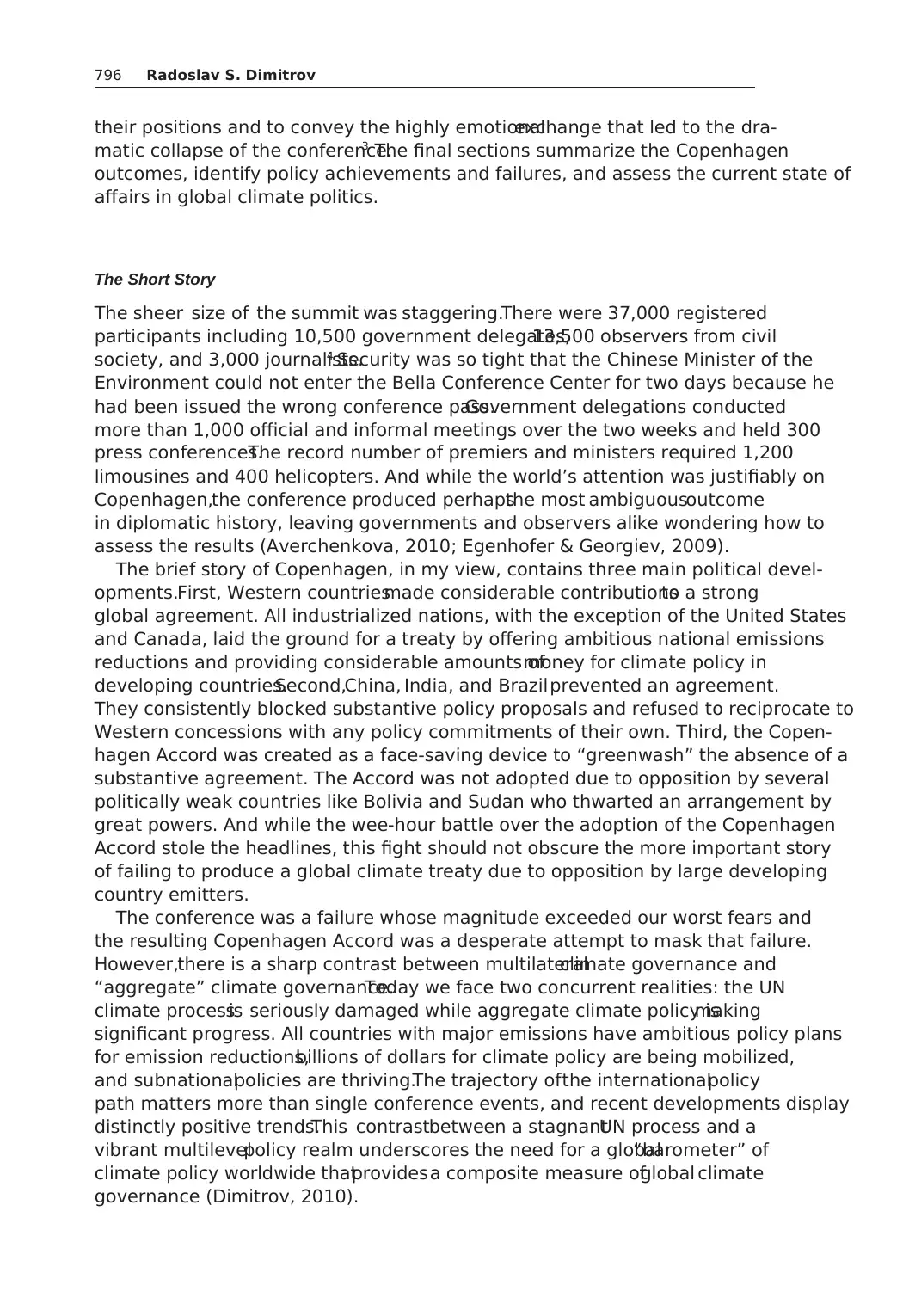
their positions and to convey the highly emotionalexchange that led to the dra-
matic collapse of the conference.3 The final sections summarize the Copenhagen
outcomes, identify policy achievements and failures, and assess the current state of
affairs in global climate politics.
The Short Story
The sheer size of the summit was staggering.There were 37,000 registered
participants including 10,500 government delegates,13,500 observers from civil
society, and 3,000 journalists.4 Security was so tight that the Chinese Minister of the
Environment could not enter the Bella Conference Center for two days because he
had been issued the wrong conference pass.Government delegations conducted
more than 1,000 official and informal meetings over the two weeks and held 300
press conferences.The record number of premiers and ministers required 1,200
limousines and 400 helicopters. And while the world’s attention was justifiably on
Copenhagen,the conference produced perhapsthe most ambiguousoutcome
in diplomatic history, leaving governments and observers alike wondering how to
assess the results (Averchenkova, 2010; Egenhofer & Georgiev, 2009).
The brief story of Copenhagen, in my view, contains three main political devel-
opments.First, Western countriesmade considerable contributionsto a strong
global agreement. All industrialized nations, with the exception of the United States
and Canada, laid the ground for a treaty by offering ambitious national emissions
reductions and providing considerable amounts ofmoney for climate policy in
developing countries.Second,China, India, and Brazilprevented an agreement.
They consistently blocked substantive policy proposals and refused to reciprocate to
Western concessions with any policy commitments of their own. Third, the Copen-
hagen Accord was created as a face-saving device to “greenwash” the absence of a
substantive agreement. The Accord was not adopted due to opposition by several
politically weak countries like Bolivia and Sudan who thwarted an arrangement by
great powers. And while the wee-hour battle over the adoption of the Copenhagen
Accord stole the headlines, this fight should not obscure the more important story
of failing to produce a global climate treaty due to opposition by large developing
country emitters.
The conference was a failure whose magnitude exceeded our worst fears and
the resulting Copenhagen Accord was a desperate attempt to mask that failure.
However,there is a sharp contrast between multilateralclimate governance and
“aggregate” climate governance.Today we face two concurrent realities: the UN
climate processis seriously damaged while aggregate climate policy ismaking
significant progress. All countries with major emissions have ambitious policy plans
for emission reductions,billions of dollars for climate policy are being mobilized,
and subnationalpolicies are thriving.The trajectory ofthe internationalpolicy
path matters more than single conference events, and recent developments display
distinctly positive trends.This contrastbetween a stagnantUN process and a
vibrant multilevelpolicy realm underscores the need for a global“barometer” of
climate policy worldwide thatprovidesa composite measure ofglobal climate
governance (Dimitrov, 2010).
796 Radoslav S. Dimitrov
matic collapse of the conference.3 The final sections summarize the Copenhagen
outcomes, identify policy achievements and failures, and assess the current state of
affairs in global climate politics.
The Short Story
The sheer size of the summit was staggering.There were 37,000 registered
participants including 10,500 government delegates,13,500 observers from civil
society, and 3,000 journalists.4 Security was so tight that the Chinese Minister of the
Environment could not enter the Bella Conference Center for two days because he
had been issued the wrong conference pass.Government delegations conducted
more than 1,000 official and informal meetings over the two weeks and held 300
press conferences.The record number of premiers and ministers required 1,200
limousines and 400 helicopters. And while the world’s attention was justifiably on
Copenhagen,the conference produced perhapsthe most ambiguousoutcome
in diplomatic history, leaving governments and observers alike wondering how to
assess the results (Averchenkova, 2010; Egenhofer & Georgiev, 2009).
The brief story of Copenhagen, in my view, contains three main political devel-
opments.First, Western countriesmade considerable contributionsto a strong
global agreement. All industrialized nations, with the exception of the United States
and Canada, laid the ground for a treaty by offering ambitious national emissions
reductions and providing considerable amounts ofmoney for climate policy in
developing countries.Second,China, India, and Brazilprevented an agreement.
They consistently blocked substantive policy proposals and refused to reciprocate to
Western concessions with any policy commitments of their own. Third, the Copen-
hagen Accord was created as a face-saving device to “greenwash” the absence of a
substantive agreement. The Accord was not adopted due to opposition by several
politically weak countries like Bolivia and Sudan who thwarted an arrangement by
great powers. And while the wee-hour battle over the adoption of the Copenhagen
Accord stole the headlines, this fight should not obscure the more important story
of failing to produce a global climate treaty due to opposition by large developing
country emitters.
The conference was a failure whose magnitude exceeded our worst fears and
the resulting Copenhagen Accord was a desperate attempt to mask that failure.
However,there is a sharp contrast between multilateralclimate governance and
“aggregate” climate governance.Today we face two concurrent realities: the UN
climate processis seriously damaged while aggregate climate policy ismaking
significant progress. All countries with major emissions have ambitious policy plans
for emission reductions,billions of dollars for climate policy are being mobilized,
and subnationalpolicies are thriving.The trajectory ofthe internationalpolicy
path matters more than single conference events, and recent developments display
distinctly positive trends.This contrastbetween a stagnantUN process and a
vibrant multilevelpolicy realm underscores the need for a global“barometer” of
climate policy worldwide thatprovidesa composite measure ofglobal climate
governance (Dimitrov, 2010).
796 Radoslav S. Dimitrov
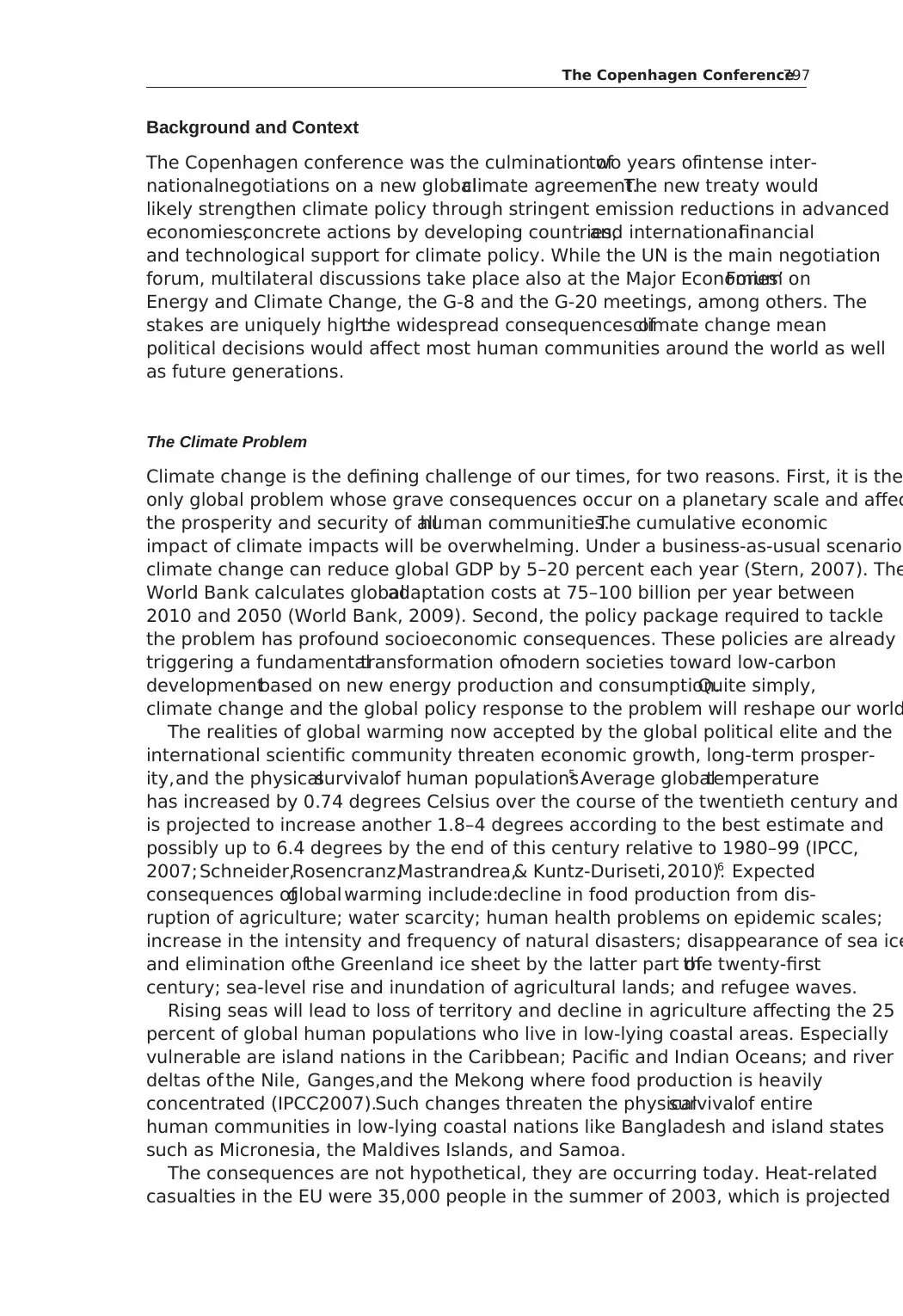
Background and Context
The Copenhagen conference was the culmination oftwo years ofintense inter-
nationalnegotiations on a new globalclimate agreement.The new treaty would
likely strengthen climate policy through stringent emission reductions in advanced
economies,concrete actions by developing countries,and internationalfinancial
and technological support for climate policy. While the UN is the main negotiation
forum, multilateral discussions take place also at the Major Economies’Forum on
Energy and Climate Change, the G-8 and the G-20 meetings, among others. The
stakes are uniquely high:the widespread consequences ofclimate change mean
political decisions would affect most human communities around the world as well
as future generations.
The Climate Problem
Climate change is the defining challenge of our times, for two reasons. First, it is the
only global problem whose grave consequences occur on a planetary scale and affec
the prosperity and security of allhuman communities.The cumulative economic
impact of climate impacts will be overwhelming. Under a business-as-usual scenario,
climate change can reduce global GDP by 5–20 percent each year (Stern, 2007). The
World Bank calculates globaladaptation costs at 75–100 billion per year between
2010 and 2050 (World Bank, 2009). Second, the policy package required to tackle
the problem has profound socioeconomic consequences. These policies are already
triggering a fundamentaltransformation ofmodern societies toward low-carbon
developmentbased on new energy production and consumption.Quite simply,
climate change and the global policy response to the problem will reshape our world
The realities of global warming now accepted by the global political elite and the
international scientific community threaten economic growth, long-term prosper-
ity,and the physicalsurvivalof human populations.5 Average globaltemperature
has increased by 0.74 degrees Celsius over the course of the twentieth century and
is projected to increase another 1.8–4 degrees according to the best estimate and
possibly up to 6.4 degrees by the end of this century relative to 1980–99 (IPCC,
2007; Schneider,Rosencranz,Mastrandrea,& Kuntz-Duriseti,2010).6 Expected
consequences ofglobal warming include:decline in food production from dis-
ruption of agriculture; water scarcity; human health problems on epidemic scales;
increase in the intensity and frequency of natural disasters; disappearance of sea ice
and elimination ofthe Greenland ice sheet by the latter part ofthe twenty-first
century; sea-level rise and inundation of agricultural lands; and refugee waves.
Rising seas will lead to loss of territory and decline in agriculture affecting the 25
percent of global human populations who live in low-lying coastal areas. Especially
vulnerable are island nations in the Caribbean; Pacific and Indian Oceans; and river
deltas of the Nile, Ganges,and the Mekong where food production is heavily
concentrated (IPCC,2007).Such changes threaten the physicalsurvivalof entire
human communities in low-lying coastal nations like Bangladesh and island states
such as Micronesia, the Maldives Islands, and Samoa.
The consequences are not hypothetical, they are occurring today. Heat-related
casualties in the EU were 35,000 people in the summer of 2003, which is projected
The Copenhagen Conference797
The Copenhagen conference was the culmination oftwo years ofintense inter-
nationalnegotiations on a new globalclimate agreement.The new treaty would
likely strengthen climate policy through stringent emission reductions in advanced
economies,concrete actions by developing countries,and internationalfinancial
and technological support for climate policy. While the UN is the main negotiation
forum, multilateral discussions take place also at the Major Economies’Forum on
Energy and Climate Change, the G-8 and the G-20 meetings, among others. The
stakes are uniquely high:the widespread consequences ofclimate change mean
political decisions would affect most human communities around the world as well
as future generations.
The Climate Problem
Climate change is the defining challenge of our times, for two reasons. First, it is the
only global problem whose grave consequences occur on a planetary scale and affec
the prosperity and security of allhuman communities.The cumulative economic
impact of climate impacts will be overwhelming. Under a business-as-usual scenario,
climate change can reduce global GDP by 5–20 percent each year (Stern, 2007). The
World Bank calculates globaladaptation costs at 75–100 billion per year between
2010 and 2050 (World Bank, 2009). Second, the policy package required to tackle
the problem has profound socioeconomic consequences. These policies are already
triggering a fundamentaltransformation ofmodern societies toward low-carbon
developmentbased on new energy production and consumption.Quite simply,
climate change and the global policy response to the problem will reshape our world
The realities of global warming now accepted by the global political elite and the
international scientific community threaten economic growth, long-term prosper-
ity,and the physicalsurvivalof human populations.5 Average globaltemperature
has increased by 0.74 degrees Celsius over the course of the twentieth century and
is projected to increase another 1.8–4 degrees according to the best estimate and
possibly up to 6.4 degrees by the end of this century relative to 1980–99 (IPCC,
2007; Schneider,Rosencranz,Mastrandrea,& Kuntz-Duriseti,2010).6 Expected
consequences ofglobal warming include:decline in food production from dis-
ruption of agriculture; water scarcity; human health problems on epidemic scales;
increase in the intensity and frequency of natural disasters; disappearance of sea ice
and elimination ofthe Greenland ice sheet by the latter part ofthe twenty-first
century; sea-level rise and inundation of agricultural lands; and refugee waves.
Rising seas will lead to loss of territory and decline in agriculture affecting the 25
percent of global human populations who live in low-lying coastal areas. Especially
vulnerable are island nations in the Caribbean; Pacific and Indian Oceans; and river
deltas of the Nile, Ganges,and the Mekong where food production is heavily
concentrated (IPCC,2007).Such changes threaten the physicalsurvivalof entire
human communities in low-lying coastal nations like Bangladesh and island states
such as Micronesia, the Maldives Islands, and Samoa.
The consequences are not hypothetical, they are occurring today. Heat-related
casualties in the EU were 35,000 people in the summer of 2003, which is projected
The Copenhagen Conference797
⊘ This is a preview!⊘
Do you want full access?
Subscribe today to unlock all pages.

Trusted by 1+ million students worldwide
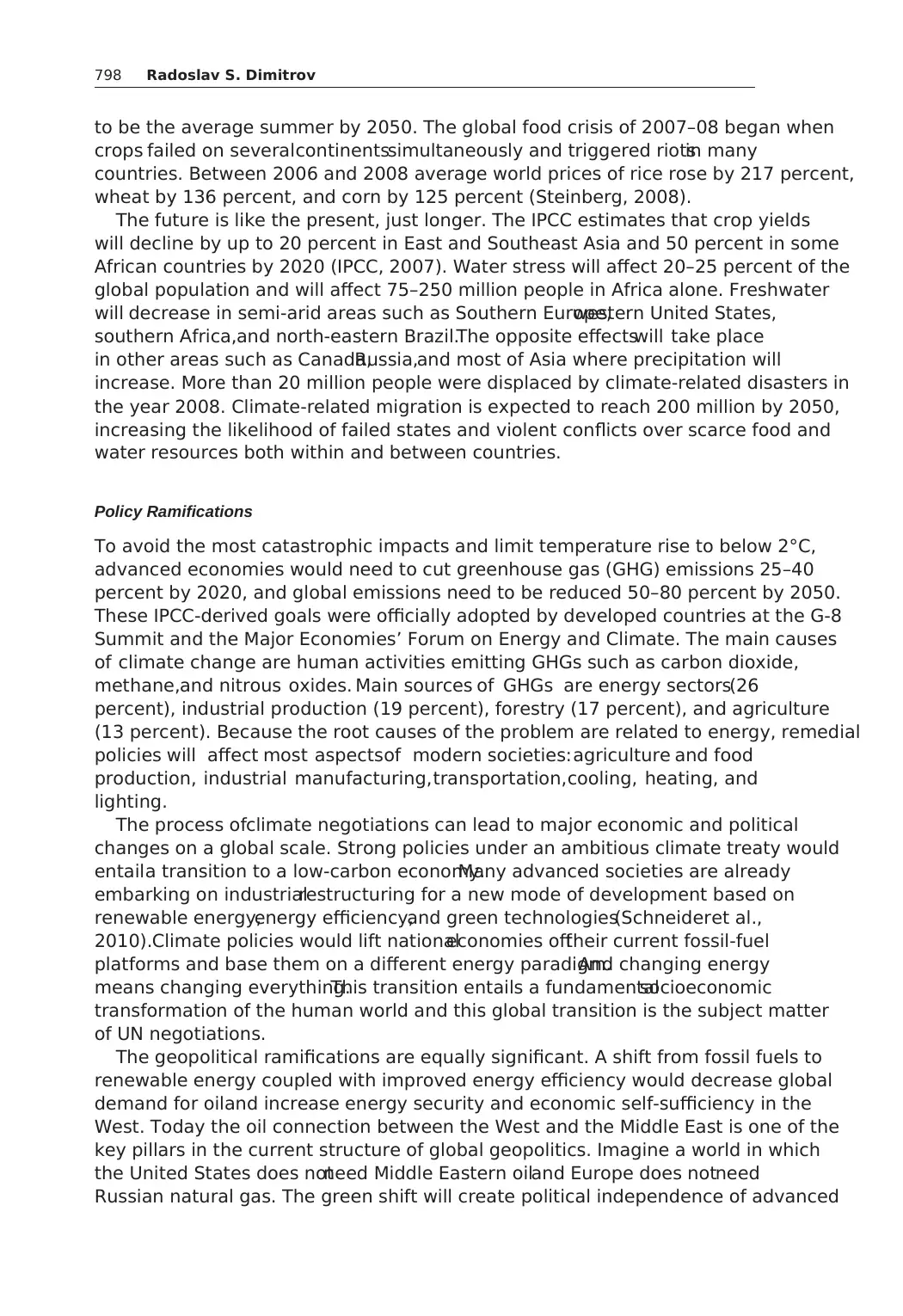
to be the average summer by 2050. The global food crisis of 2007–08 began when
crops failed on severalcontinentssimultaneously and triggered riotsin many
countries. Between 2006 and 2008 average world prices of rice rose by 217 percent,
wheat by 136 percent, and corn by 125 percent (Steinberg, 2008).
The future is like the present, just longer. The IPCC estimates that crop yields
will decline by up to 20 percent in East and Southeast Asia and 50 percent in some
African countries by 2020 (IPCC, 2007). Water stress will affect 20–25 percent of the
global population and will affect 75–250 million people in Africa alone. Freshwater
will decrease in semi-arid areas such as Southern Europe,western United States,
southern Africa,and north-eastern Brazil.The opposite effectswill take place
in other areas such as Canada,Russia,and most of Asia where precipitation will
increase. More than 20 million people were displaced by climate-related disasters in
the year 2008. Climate-related migration is expected to reach 200 million by 2050,
increasing the likelihood of failed states and violent conflicts over scarce food and
water resources both within and between countries.
Policy Ramifications
To avoid the most catastrophic impacts and limit temperature rise to below 2°C,
advanced economies would need to cut greenhouse gas (GHG) emissions 25–40
percent by 2020, and global emissions need to be reduced 50–80 percent by 2050.
These IPCC-derived goals were officially adopted by developed countries at the G-8
Summit and the Major Economies’ Forum on Energy and Climate. The main causes
of climate change are human activities emitting GHGs such as carbon dioxide,
methane,and nitrous oxides. Main sources of GHGs are energy sectors(26
percent), industrial production (19 percent), forestry (17 percent), and agriculture
(13 percent). Because the root causes of the problem are related to energy, remedial
policies will affect most aspectsof modern societies:agriculture and food
production, industrial manufacturing,transportation,cooling, heating, and
lighting.
The process ofclimate negotiations can lead to major economic and political
changes on a global scale. Strong policies under an ambitious climate treaty would
entaila transition to a low-carbon economy.Many advanced societies are already
embarking on industrialrestructuring for a new mode of development based on
renewable energy,energy efficiency,and green technologies(Schneideret al.,
2010).Climate policies would lift nationaleconomies offtheir current fossil-fuel
platforms and base them on a different energy paradigm.And changing energy
means changing everything.This transition entails a fundamentalsocioeconomic
transformation of the human world and this global transition is the subject matter
of UN negotiations.
The geopolitical ramifications are equally significant. A shift from fossil fuels to
renewable energy coupled with improved energy efficiency would decrease global
demand for oiland increase energy security and economic self-sufficiency in the
West. Today the oil connection between the West and the Middle East is one of the
key pillars in the current structure of global geopolitics. Imagine a world in which
the United States does notneed Middle Eastern oiland Europe does notneed
Russian natural gas. The green shift will create political independence of advanced
798 Radoslav S. Dimitrov
crops failed on severalcontinentssimultaneously and triggered riotsin many
countries. Between 2006 and 2008 average world prices of rice rose by 217 percent,
wheat by 136 percent, and corn by 125 percent (Steinberg, 2008).
The future is like the present, just longer. The IPCC estimates that crop yields
will decline by up to 20 percent in East and Southeast Asia and 50 percent in some
African countries by 2020 (IPCC, 2007). Water stress will affect 20–25 percent of the
global population and will affect 75–250 million people in Africa alone. Freshwater
will decrease in semi-arid areas such as Southern Europe,western United States,
southern Africa,and north-eastern Brazil.The opposite effectswill take place
in other areas such as Canada,Russia,and most of Asia where precipitation will
increase. More than 20 million people were displaced by climate-related disasters in
the year 2008. Climate-related migration is expected to reach 200 million by 2050,
increasing the likelihood of failed states and violent conflicts over scarce food and
water resources both within and between countries.
Policy Ramifications
To avoid the most catastrophic impacts and limit temperature rise to below 2°C,
advanced economies would need to cut greenhouse gas (GHG) emissions 25–40
percent by 2020, and global emissions need to be reduced 50–80 percent by 2050.
These IPCC-derived goals were officially adopted by developed countries at the G-8
Summit and the Major Economies’ Forum on Energy and Climate. The main causes
of climate change are human activities emitting GHGs such as carbon dioxide,
methane,and nitrous oxides. Main sources of GHGs are energy sectors(26
percent), industrial production (19 percent), forestry (17 percent), and agriculture
(13 percent). Because the root causes of the problem are related to energy, remedial
policies will affect most aspectsof modern societies:agriculture and food
production, industrial manufacturing,transportation,cooling, heating, and
lighting.
The process ofclimate negotiations can lead to major economic and political
changes on a global scale. Strong policies under an ambitious climate treaty would
entaila transition to a low-carbon economy.Many advanced societies are already
embarking on industrialrestructuring for a new mode of development based on
renewable energy,energy efficiency,and green technologies(Schneideret al.,
2010).Climate policies would lift nationaleconomies offtheir current fossil-fuel
platforms and base them on a different energy paradigm.And changing energy
means changing everything.This transition entails a fundamentalsocioeconomic
transformation of the human world and this global transition is the subject matter
of UN negotiations.
The geopolitical ramifications are equally significant. A shift from fossil fuels to
renewable energy coupled with improved energy efficiency would decrease global
demand for oiland increase energy security and economic self-sufficiency in the
West. Today the oil connection between the West and the Middle East is one of the
key pillars in the current structure of global geopolitics. Imagine a world in which
the United States does notneed Middle Eastern oiland Europe does notneed
Russian natural gas. The green shift will create political independence of advanced
798 Radoslav S. Dimitrov
Paraphrase This Document
Need a fresh take? Get an instant paraphrase of this document with our AI Paraphraser
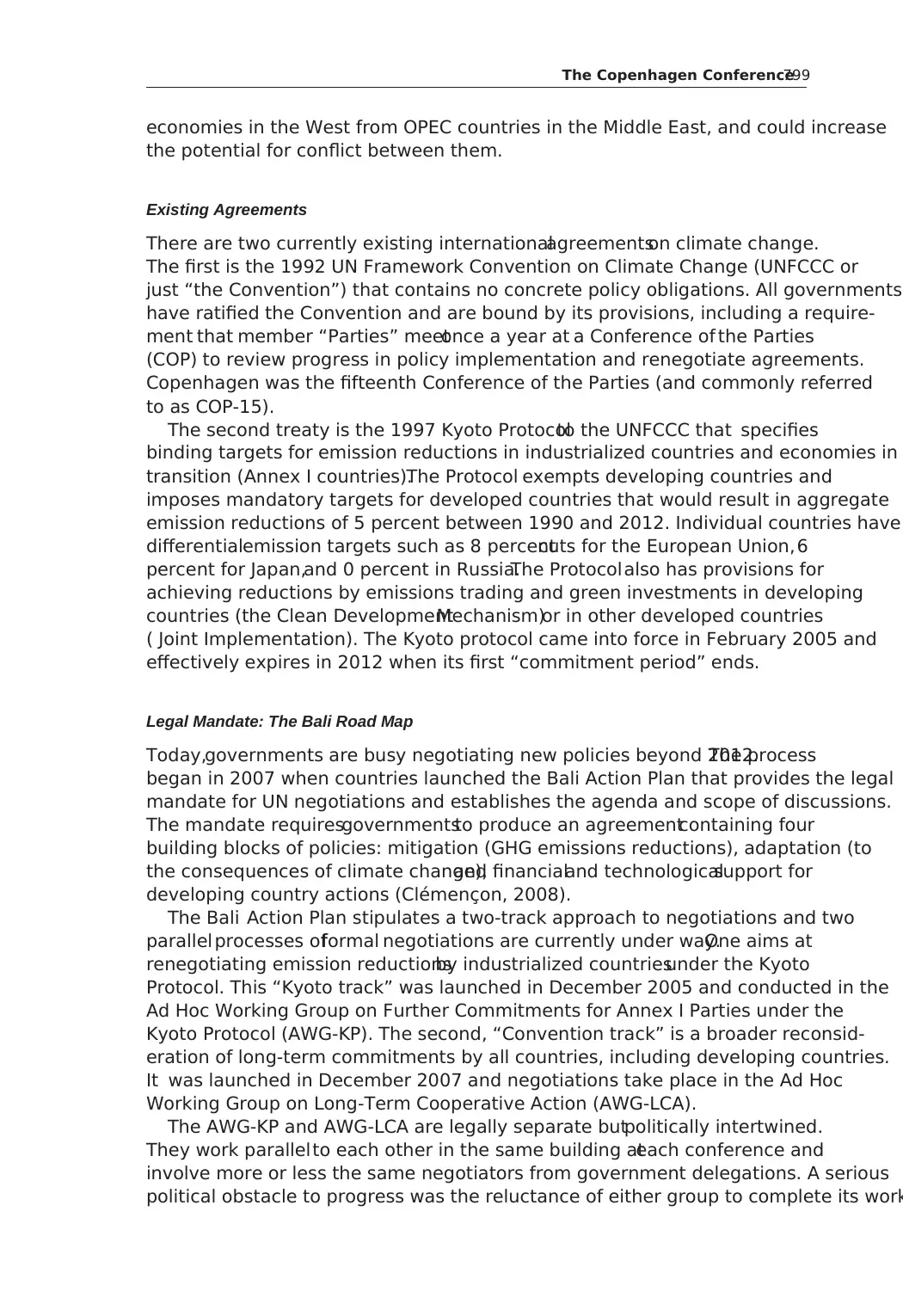
economies in the West from OPEC countries in the Middle East, and could increase
the potential for conflict between them.
Existing Agreements
There are two currently existing internationalagreementson climate change.
The first is the 1992 UN Framework Convention on Climate Change (UNFCCC or
just “the Convention”) that contains no concrete policy obligations. All governments
have ratified the Convention and are bound by its provisions, including a require-
ment that member “Parties” meetonce a year at a Conference of the Parties
(COP) to review progress in policy implementation and renegotiate agreements.
Copenhagen was the fifteenth Conference of the Parties (and commonly referred
to as COP-15).
The second treaty is the 1997 Kyoto Protocolto the UNFCCC that specifies
binding targets for emission reductions in industrialized countries and economies in
transition (Annex I countries).The Protocol exempts developing countries and
imposes mandatory targets for developed countries that would result in aggregate
emission reductions of 5 percent between 1990 and 2012. Individual countries have
differentialemission targets such as 8 percentcuts for the European Union,6
percent for Japan,and 0 percent in Russia.The Protocolalso has provisions for
achieving reductions by emissions trading and green investments in developing
countries (the Clean DevelopmentMechanism)or in other developed countries
( Joint Implementation). The Kyoto protocol came into force in February 2005 and
effectively expires in 2012 when its first “commitment period” ends.
Legal Mandate: The Bali Road Map
Today,governments are busy negotiating new policies beyond 2012.The process
began in 2007 when countries launched the Bali Action Plan that provides the legal
mandate for UN negotiations and establishes the agenda and scope of discussions.
The mandate requiresgovernmentsto produce an agreementcontaining four
building blocks of policies: mitigation (GHG emissions reductions), adaptation (to
the consequences of climate change),and financialand technologicalsupport for
developing country actions (Clémençon, 2008).
The Bali Action Plan stipulates a two-track approach to negotiations and two
parallel processes offormal negotiations are currently under way.One aims at
renegotiating emission reductionsby industrialized countriesunder the Kyoto
Protocol. This “Kyoto track” was launched in December 2005 and conducted in the
Ad Hoc Working Group on Further Commitments for Annex I Parties under the
Kyoto Protocol (AWG-KP). The second, “Convention track” is a broader reconsid-
eration of long-term commitments by all countries, including developing countries.
It was launched in December 2007 and negotiations take place in the Ad Hoc
Working Group on Long-Term Cooperative Action (AWG-LCA).
The AWG-KP and AWG-LCA are legally separate butpolitically intertwined.
They work parallelto each other in the same building ateach conference and
involve more or less the same negotiators from government delegations. A serious
political obstacle to progress was the reluctance of either group to complete its work
The Copenhagen Conference799
the potential for conflict between them.
Existing Agreements
There are two currently existing internationalagreementson climate change.
The first is the 1992 UN Framework Convention on Climate Change (UNFCCC or
just “the Convention”) that contains no concrete policy obligations. All governments
have ratified the Convention and are bound by its provisions, including a require-
ment that member “Parties” meetonce a year at a Conference of the Parties
(COP) to review progress in policy implementation and renegotiate agreements.
Copenhagen was the fifteenth Conference of the Parties (and commonly referred
to as COP-15).
The second treaty is the 1997 Kyoto Protocolto the UNFCCC that specifies
binding targets for emission reductions in industrialized countries and economies in
transition (Annex I countries).The Protocol exempts developing countries and
imposes mandatory targets for developed countries that would result in aggregate
emission reductions of 5 percent between 1990 and 2012. Individual countries have
differentialemission targets such as 8 percentcuts for the European Union,6
percent for Japan,and 0 percent in Russia.The Protocolalso has provisions for
achieving reductions by emissions trading and green investments in developing
countries (the Clean DevelopmentMechanism)or in other developed countries
( Joint Implementation). The Kyoto protocol came into force in February 2005 and
effectively expires in 2012 when its first “commitment period” ends.
Legal Mandate: The Bali Road Map
Today,governments are busy negotiating new policies beyond 2012.The process
began in 2007 when countries launched the Bali Action Plan that provides the legal
mandate for UN negotiations and establishes the agenda and scope of discussions.
The mandate requiresgovernmentsto produce an agreementcontaining four
building blocks of policies: mitigation (GHG emissions reductions), adaptation (to
the consequences of climate change),and financialand technologicalsupport for
developing country actions (Clémençon, 2008).
The Bali Action Plan stipulates a two-track approach to negotiations and two
parallel processes offormal negotiations are currently under way.One aims at
renegotiating emission reductionsby industrialized countriesunder the Kyoto
Protocol. This “Kyoto track” was launched in December 2005 and conducted in the
Ad Hoc Working Group on Further Commitments for Annex I Parties under the
Kyoto Protocol (AWG-KP). The second, “Convention track” is a broader reconsid-
eration of long-term commitments by all countries, including developing countries.
It was launched in December 2007 and negotiations take place in the Ad Hoc
Working Group on Long-Term Cooperative Action (AWG-LCA).
The AWG-KP and AWG-LCA are legally separate butpolitically intertwined.
They work parallelto each other in the same building ateach conference and
involve more or less the same negotiators from government delegations. A serious
political obstacle to progress was the reluctance of either group to complete its work
The Copenhagen Conference799
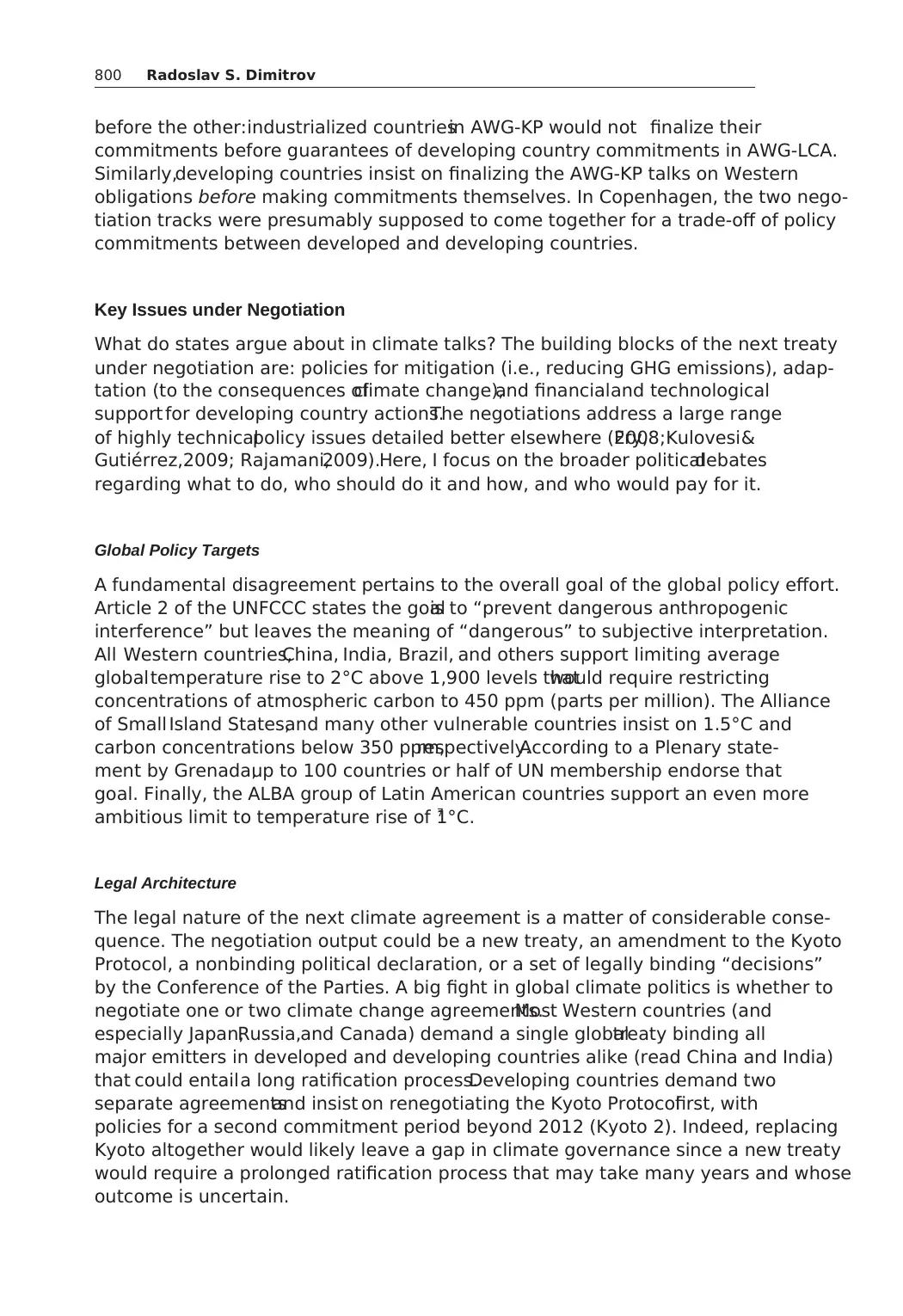
before the other:industrialized countriesin AWG-KP would not finalize their
commitments before guarantees of developing country commitments in AWG-LCA.
Similarly,developing countries insist on finalizing the AWG-KP talks on Western
obligations before making commitments themselves. In Copenhagen, the two nego-
tiation tracks were presumably supposed to come together for a trade-off of policy
commitments between developed and developing countries.
Key Issues under Negotiation
What do states argue about in climate talks? The building blocks of the next treaty
under negotiation are: policies for mitigation (i.e., reducing GHG emissions), adap-
tation (to the consequences ofclimate change),and financialand technological
support for developing country actions.The negotiations address a large range
of highly technicalpolicy issues detailed better elsewhere (Fry,2008;Kulovesi&
Gutiérrez,2009; Rajamani,2009).Here, I focus on the broader politicaldebates
regarding what to do, who should do it and how, and who would pay for it.
Global Policy Targets
A fundamental disagreement pertains to the overall goal of the global policy effort.
Article 2 of the UNFCCC states the goalis to “prevent dangerous anthropogenic
interference” but leaves the meaning of “dangerous” to subjective interpretation.
All Western countries,China, India, Brazil, and others support limiting average
globaltemperature rise to 2°C above 1,900 levels thatwould require restricting
concentrations of atmospheric carbon to 450 ppm (parts per million). The Alliance
of Small Island States,and many other vulnerable countries insist on 1.5°C and
carbon concentrations below 350 ppm,respectively.According to a Plenary state-
ment by Grenada,up to 100 countries or half of UN membership endorse that
goal. Finally, the ALBA group of Latin American countries support an even more
ambitious limit to temperature rise of 1°C.7
Legal Architecture
The legal nature of the next climate agreement is a matter of considerable conse-
quence. The negotiation output could be a new treaty, an amendment to the Kyoto
Protocol, a nonbinding political declaration, or a set of legally binding “decisions”
by the Conference of the Parties. A big fight in global climate politics is whether to
negotiate one or two climate change agreements.Most Western countries (and
especially Japan,Russia,and Canada) demand a single globaltreaty binding all
major emitters in developed and developing countries alike (read China and India)
that could entaila long ratification process.Developing countries demand two
separate agreementsand insist on renegotiating the Kyoto Protocolfirst, with
policies for a second commitment period beyond 2012 (Kyoto 2). Indeed, replacing
Kyoto altogether would likely leave a gap in climate governance since a new treaty
would require a prolonged ratification process that may take many years and whose
outcome is uncertain.
800 Radoslav S. Dimitrov
commitments before guarantees of developing country commitments in AWG-LCA.
Similarly,developing countries insist on finalizing the AWG-KP talks on Western
obligations before making commitments themselves. In Copenhagen, the two nego-
tiation tracks were presumably supposed to come together for a trade-off of policy
commitments between developed and developing countries.
Key Issues under Negotiation
What do states argue about in climate talks? The building blocks of the next treaty
under negotiation are: policies for mitigation (i.e., reducing GHG emissions), adap-
tation (to the consequences ofclimate change),and financialand technological
support for developing country actions.The negotiations address a large range
of highly technicalpolicy issues detailed better elsewhere (Fry,2008;Kulovesi&
Gutiérrez,2009; Rajamani,2009).Here, I focus on the broader politicaldebates
regarding what to do, who should do it and how, and who would pay for it.
Global Policy Targets
A fundamental disagreement pertains to the overall goal of the global policy effort.
Article 2 of the UNFCCC states the goalis to “prevent dangerous anthropogenic
interference” but leaves the meaning of “dangerous” to subjective interpretation.
All Western countries,China, India, Brazil, and others support limiting average
globaltemperature rise to 2°C above 1,900 levels thatwould require restricting
concentrations of atmospheric carbon to 450 ppm (parts per million). The Alliance
of Small Island States,and many other vulnerable countries insist on 1.5°C and
carbon concentrations below 350 ppm,respectively.According to a Plenary state-
ment by Grenada,up to 100 countries or half of UN membership endorse that
goal. Finally, the ALBA group of Latin American countries support an even more
ambitious limit to temperature rise of 1°C.7
Legal Architecture
The legal nature of the next climate agreement is a matter of considerable conse-
quence. The negotiation output could be a new treaty, an amendment to the Kyoto
Protocol, a nonbinding political declaration, or a set of legally binding “decisions”
by the Conference of the Parties. A big fight in global climate politics is whether to
negotiate one or two climate change agreements.Most Western countries (and
especially Japan,Russia,and Canada) demand a single globaltreaty binding all
major emitters in developed and developing countries alike (read China and India)
that could entaila long ratification process.Developing countries demand two
separate agreementsand insist on renegotiating the Kyoto Protocolfirst, with
policies for a second commitment period beyond 2012 (Kyoto 2). Indeed, replacing
Kyoto altogether would likely leave a gap in climate governance since a new treaty
would require a prolonged ratification process that may take many years and whose
outcome is uncertain.
800 Radoslav S. Dimitrov
⊘ This is a preview!⊘
Do you want full access?
Subscribe today to unlock all pages.

Trusted by 1+ million students worldwide
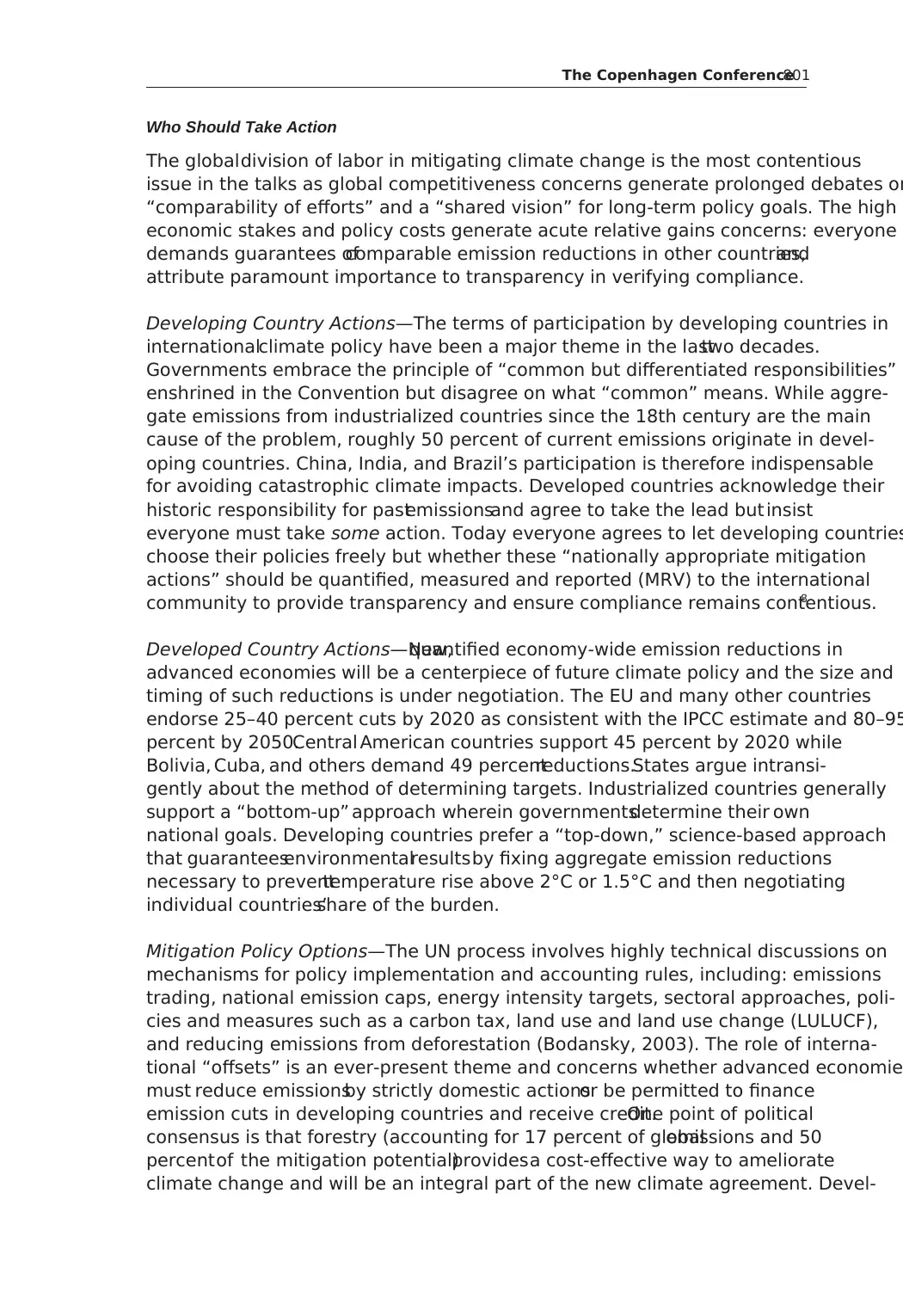
Who Should Take Action
The globaldivision of labor in mitigating climate change is the most contentious
issue in the talks as global competitiveness concerns generate prolonged debates on
“comparability of efforts” and a “shared vision” for long-term policy goals. The high
economic stakes and policy costs generate acute relative gains concerns: everyone
demands guarantees ofcomparable emission reductions in other countries,and
attribute paramount importance to transparency in verifying compliance.
Developing Country Actions—The terms of participation by developing countries in
internationalclimate policy have been a major theme in the lasttwo decades.
Governments embrace the principle of “common but differentiated responsibilities”
enshrined in the Convention but disagree on what “common” means. While aggre-
gate emissions from industrialized countries since the 18th century are the main
cause of the problem, roughly 50 percent of current emissions originate in devel-
oping countries. China, India, and Brazil’s participation is therefore indispensable
for avoiding catastrophic climate impacts. Developed countries acknowledge their
historic responsibility for pastemissionsand agree to take the lead but insist
everyone must take some action. Today everyone agrees to let developing countries
choose their policies freely but whether these “nationally appropriate mitigation
actions” should be quantified, measured and reported (MRV) to the international
community to provide transparency and ensure compliance remains contentious.8
Developed Country Actions—New,quantified economy-wide emission reductions in
advanced economies will be a centerpiece of future climate policy and the size and
timing of such reductions is under negotiation. The EU and many other countries
endorse 25–40 percent cuts by 2020 as consistent with the IPCC estimate and 80–95
percent by 2050.Central American countries support 45 percent by 2020 while
Bolivia, Cuba, and others demand 49 percentreductions.States argue intransi-
gently about the method of determining targets. Industrialized countries generally
support a “bottom-up” approach wherein governmentsdetermine their own
national goals. Developing countries prefer a “top-down,” science-based approach
that guaranteesenvironmentalresultsby fixing aggregate emission reductions
necessary to preventtemperature rise above 2°C or 1.5°C and then negotiating
individual countries’share of the burden.
Mitigation Policy Options—The UN process involves highly technical discussions on
mechanisms for policy implementation and accounting rules, including: emissions
trading, national emission caps, energy intensity targets, sectoral approaches, poli-
cies and measures such as a carbon tax, land use and land use change (LULUCF),
and reducing emissions from deforestation (Bodansky, 2003). The role of interna-
tional “offsets” is an ever-present theme and concerns whether advanced economie
must reduce emissionsby strictly domestic actionsor be permitted to finance
emission cuts in developing countries and receive credit.One point of political
consensus is that forestry (accounting for 17 percent of globalemissions and 50
percentof the mitigation potential)providesa cost-effective way to ameliorate
climate change and will be an integral part of the new climate agreement. Devel-
The Copenhagen Conference801
The globaldivision of labor in mitigating climate change is the most contentious
issue in the talks as global competitiveness concerns generate prolonged debates on
“comparability of efforts” and a “shared vision” for long-term policy goals. The high
economic stakes and policy costs generate acute relative gains concerns: everyone
demands guarantees ofcomparable emission reductions in other countries,and
attribute paramount importance to transparency in verifying compliance.
Developing Country Actions—The terms of participation by developing countries in
internationalclimate policy have been a major theme in the lasttwo decades.
Governments embrace the principle of “common but differentiated responsibilities”
enshrined in the Convention but disagree on what “common” means. While aggre-
gate emissions from industrialized countries since the 18th century are the main
cause of the problem, roughly 50 percent of current emissions originate in devel-
oping countries. China, India, and Brazil’s participation is therefore indispensable
for avoiding catastrophic climate impacts. Developed countries acknowledge their
historic responsibility for pastemissionsand agree to take the lead but insist
everyone must take some action. Today everyone agrees to let developing countries
choose their policies freely but whether these “nationally appropriate mitigation
actions” should be quantified, measured and reported (MRV) to the international
community to provide transparency and ensure compliance remains contentious.8
Developed Country Actions—New,quantified economy-wide emission reductions in
advanced economies will be a centerpiece of future climate policy and the size and
timing of such reductions is under negotiation. The EU and many other countries
endorse 25–40 percent cuts by 2020 as consistent with the IPCC estimate and 80–95
percent by 2050.Central American countries support 45 percent by 2020 while
Bolivia, Cuba, and others demand 49 percentreductions.States argue intransi-
gently about the method of determining targets. Industrialized countries generally
support a “bottom-up” approach wherein governmentsdetermine their own
national goals. Developing countries prefer a “top-down,” science-based approach
that guaranteesenvironmentalresultsby fixing aggregate emission reductions
necessary to preventtemperature rise above 2°C or 1.5°C and then negotiating
individual countries’share of the burden.
Mitigation Policy Options—The UN process involves highly technical discussions on
mechanisms for policy implementation and accounting rules, including: emissions
trading, national emission caps, energy intensity targets, sectoral approaches, poli-
cies and measures such as a carbon tax, land use and land use change (LULUCF),
and reducing emissions from deforestation (Bodansky, 2003). The role of interna-
tional “offsets” is an ever-present theme and concerns whether advanced economie
must reduce emissionsby strictly domestic actionsor be permitted to finance
emission cuts in developing countries and receive credit.One point of political
consensus is that forestry (accounting for 17 percent of globalemissions and 50
percentof the mitigation potential)providesa cost-effective way to ameliorate
climate change and will be an integral part of the new climate agreement. Devel-
The Copenhagen Conference801
Paraphrase This Document
Need a fresh take? Get an instant paraphrase of this document with our AI Paraphraser
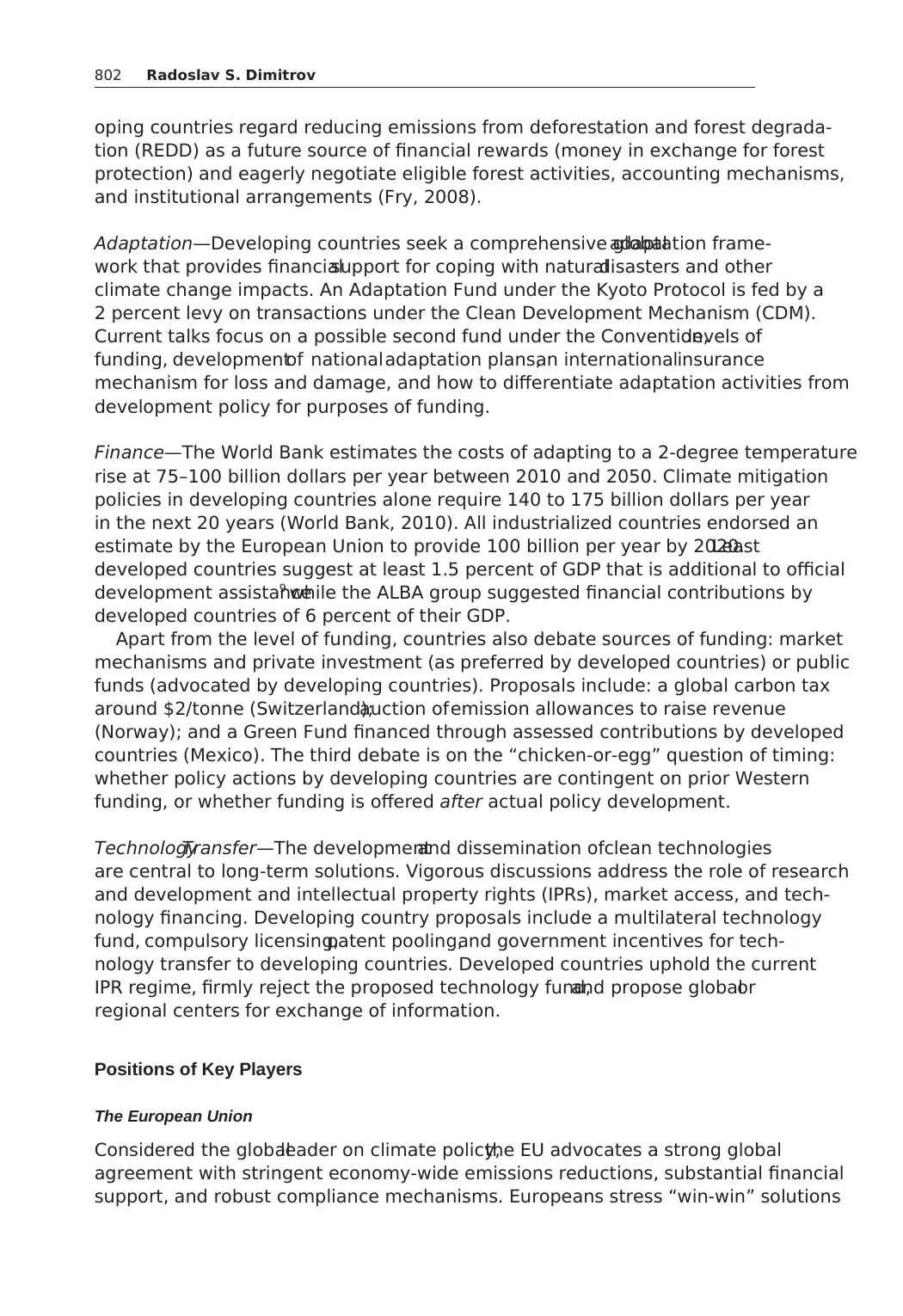
oping countries regard reducing emissions from deforestation and forest degrada-
tion (REDD) as a future source of financial rewards (money in exchange for forest
protection) and eagerly negotiate eligible forest activities, accounting mechanisms,
and institutional arrangements (Fry, 2008).
Adaptation—Developing countries seek a comprehensive globaladaptation frame-
work that provides financialsupport for coping with naturaldisasters and other
climate change impacts. An Adaptation Fund under the Kyoto Protocol is fed by a
2 percent levy on transactions under the Clean Development Mechanism (CDM).
Current talks focus on a possible second fund under the Convention,levels of
funding, developmentof nationaladaptation plans,an internationalinsurance
mechanism for loss and damage, and how to differentiate adaptation activities from
development policy for purposes of funding.
Finance—The World Bank estimates the costs of adapting to a 2-degree temperature
rise at 75–100 billion dollars per year between 2010 and 2050. Climate mitigation
policies in developing countries alone require 140 to 175 billion dollars per year
in the next 20 years (World Bank, 2010). All industrialized countries endorsed an
estimate by the European Union to provide 100 billion per year by 2020.Least
developed countries suggest at least 1.5 percent of GDP that is additional to official
development assistance9 while the ALBA group suggested financial contributions by
developed countries of 6 percent of their GDP.
Apart from the level of funding, countries also debate sources of funding: market
mechanisms and private investment (as preferred by developed countries) or public
funds (advocated by developing countries). Proposals include: a global carbon tax
around $2/tonne (Switzerland);auction ofemission allowances to raise revenue
(Norway); and a Green Fund financed through assessed contributions by developed
countries (Mexico). The third debate is on the “chicken-or-egg” question of timing:
whether policy actions by developing countries are contingent on prior Western
funding, or whether funding is offered after actual policy development.
TechnologyTransfer—The developmentand dissemination ofclean technologies
are central to long-term solutions. Vigorous discussions address the role of research
and development and intellectual property rights (IPRs), market access, and tech-
nology financing. Developing country proposals include a multilateral technology
fund, compulsory licensing,patent pooling,and government incentives for tech-
nology transfer to developing countries. Developed countries uphold the current
IPR regime, firmly reject the proposed technology fund,and propose globalor
regional centers for exchange of information.
Positions of Key Players
The European Union
Considered the globalleader on climate policy,the EU advocates a strong global
agreement with stringent economy-wide emissions reductions, substantial financial
support, and robust compliance mechanisms. Europeans stress “win-win” solutions
802 Radoslav S. Dimitrov
tion (REDD) as a future source of financial rewards (money in exchange for forest
protection) and eagerly negotiate eligible forest activities, accounting mechanisms,
and institutional arrangements (Fry, 2008).
Adaptation—Developing countries seek a comprehensive globaladaptation frame-
work that provides financialsupport for coping with naturaldisasters and other
climate change impacts. An Adaptation Fund under the Kyoto Protocol is fed by a
2 percent levy on transactions under the Clean Development Mechanism (CDM).
Current talks focus on a possible second fund under the Convention,levels of
funding, developmentof nationaladaptation plans,an internationalinsurance
mechanism for loss and damage, and how to differentiate adaptation activities from
development policy for purposes of funding.
Finance—The World Bank estimates the costs of adapting to a 2-degree temperature
rise at 75–100 billion dollars per year between 2010 and 2050. Climate mitigation
policies in developing countries alone require 140 to 175 billion dollars per year
in the next 20 years (World Bank, 2010). All industrialized countries endorsed an
estimate by the European Union to provide 100 billion per year by 2020.Least
developed countries suggest at least 1.5 percent of GDP that is additional to official
development assistance9 while the ALBA group suggested financial contributions by
developed countries of 6 percent of their GDP.
Apart from the level of funding, countries also debate sources of funding: market
mechanisms and private investment (as preferred by developed countries) or public
funds (advocated by developing countries). Proposals include: a global carbon tax
around $2/tonne (Switzerland);auction ofemission allowances to raise revenue
(Norway); and a Green Fund financed through assessed contributions by developed
countries (Mexico). The third debate is on the “chicken-or-egg” question of timing:
whether policy actions by developing countries are contingent on prior Western
funding, or whether funding is offered after actual policy development.
TechnologyTransfer—The developmentand dissemination ofclean technologies
are central to long-term solutions. Vigorous discussions address the role of research
and development and intellectual property rights (IPRs), market access, and tech-
nology financing. Developing country proposals include a multilateral technology
fund, compulsory licensing,patent pooling,and government incentives for tech-
nology transfer to developing countries. Developed countries uphold the current
IPR regime, firmly reject the proposed technology fund,and propose globalor
regional centers for exchange of information.
Positions of Key Players
The European Union
Considered the globalleader on climate policy,the EU advocates a strong global
agreement with stringent economy-wide emissions reductions, substantial financial
support, and robust compliance mechanisms. Europeans stress “win-win” solutions
802 Radoslav S. Dimitrov
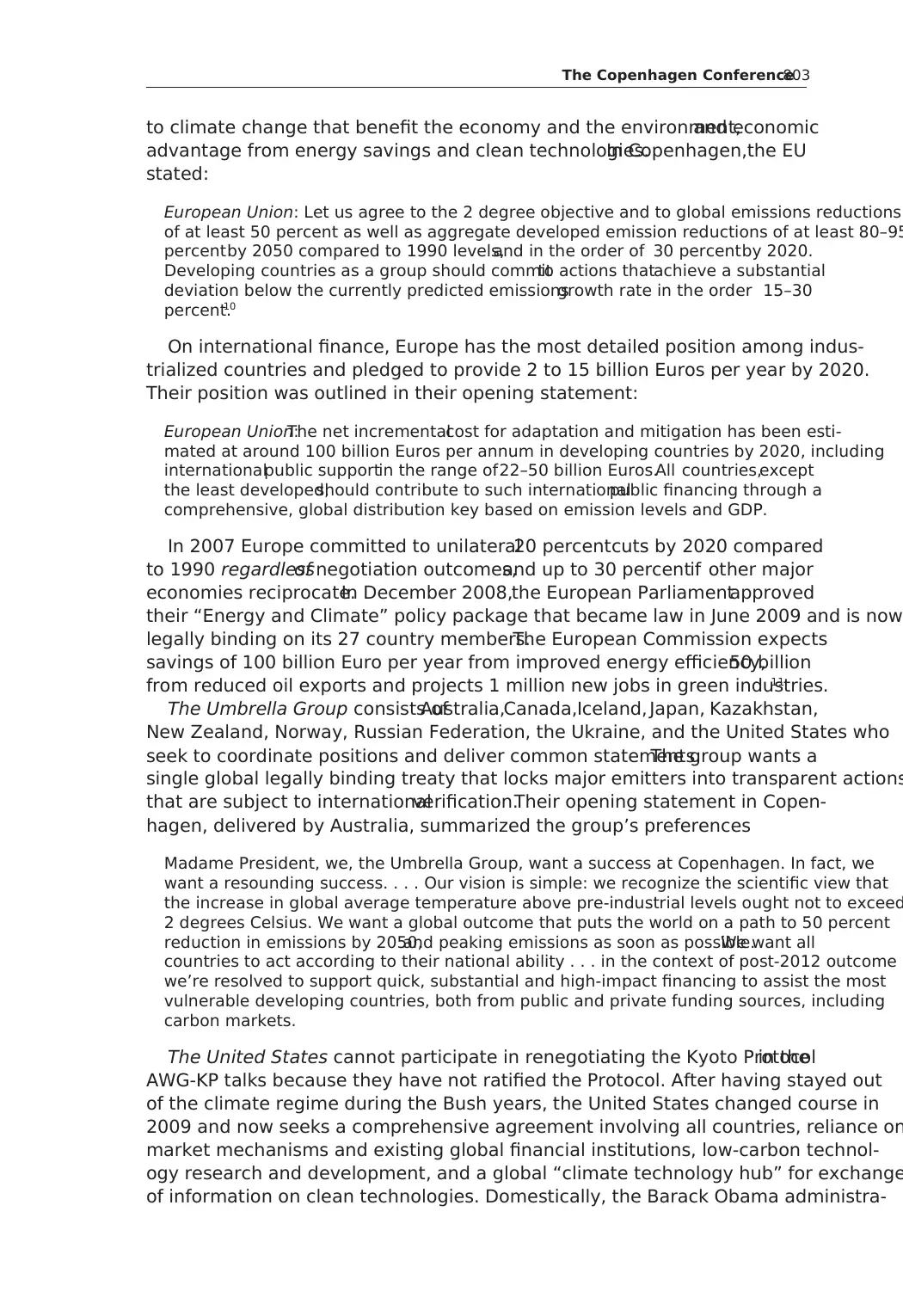
to climate change that benefit the economy and the environment,and economic
advantage from energy savings and clean technologies.In Copenhagen,the EU
stated:
European Union: Let us agree to the 2 degree objective and to global emissions reductions
of at least 50 percent as well as aggregate developed emission reductions of at least 80–95
percentby 2050 compared to 1990 levels,and in the order of 30 percentby 2020.
Developing countries as a group should committo actions thatachieve a substantial
deviation below the currently predicted emissionsgrowth rate in the order 15–30
percent.10
On international finance, Europe has the most detailed position among indus-
trialized countries and pledged to provide 2 to 15 billion Euros per year by 2020.
Their position was outlined in their opening statement:
European Union:The net incrementalcost for adaptation and mitigation has been esti-
mated at around 100 billion Euros per annum in developing countries by 2020, including
internationalpublic supportin the range of22–50 billion Euros.All countries,except
the least developed,should contribute to such internationalpublic financing through a
comprehensive, global distribution key based on emission levels and GDP.
In 2007 Europe committed to unilateral20 percentcuts by 2020 compared
to 1990 regardlessof negotiation outcomes,and up to 30 percentif other major
economies reciprocate.In December 2008,the European Parliamentapproved
their “Energy and Climate” policy package that became law in June 2009 and is now
legally binding on its 27 country members.The European Commission expects
savings of 100 billion Euro per year from improved energy efficiency,50 billion
from reduced oil exports and projects 1 million new jobs in green industries.11
The Umbrella Group consists ofAustralia,Canada,Iceland, Japan, Kazakhstan,
New Zealand, Norway, Russian Federation, the Ukraine, and the United States who
seek to coordinate positions and deliver common statements.The group wants a
single global legally binding treaty that locks major emitters into transparent actions
that are subject to internationalverification.Their opening statement in Copen-
hagen, delivered by Australia, summarized the group’s preferences
Madame President, we, the Umbrella Group, want a success at Copenhagen. In fact, we
want a resounding success. . . . Our vision is simple: we recognize the scientific view that
the increase in global average temperature above pre-industrial levels ought not to exceed
2 degrees Celsius. We want a global outcome that puts the world on a path to 50 percent
reduction in emissions by 2050,and peaking emissions as soon as possible.We want all
countries to act according to their national ability . . . in the context of post-2012 outcome
we’re resolved to support quick, substantial and high-impact financing to assist the most
vulnerable developing countries, both from public and private funding sources, including
carbon markets.
The United States cannot participate in renegotiating the Kyoto Protocolin the
AWG-KP talks because they have not ratified the Protocol. After having stayed out
of the climate regime during the Bush years, the United States changed course in
2009 and now seeks a comprehensive agreement involving all countries, reliance on
market mechanisms and existing global financial institutions, low-carbon technol-
ogy research and development, and a global “climate technology hub” for exchange
of information on clean technologies. Domestically, the Barack Obama administra-
The Copenhagen Conference803
advantage from energy savings and clean technologies.In Copenhagen,the EU
stated:
European Union: Let us agree to the 2 degree objective and to global emissions reductions
of at least 50 percent as well as aggregate developed emission reductions of at least 80–95
percentby 2050 compared to 1990 levels,and in the order of 30 percentby 2020.
Developing countries as a group should committo actions thatachieve a substantial
deviation below the currently predicted emissionsgrowth rate in the order 15–30
percent.10
On international finance, Europe has the most detailed position among indus-
trialized countries and pledged to provide 2 to 15 billion Euros per year by 2020.
Their position was outlined in their opening statement:
European Union:The net incrementalcost for adaptation and mitigation has been esti-
mated at around 100 billion Euros per annum in developing countries by 2020, including
internationalpublic supportin the range of22–50 billion Euros.All countries,except
the least developed,should contribute to such internationalpublic financing through a
comprehensive, global distribution key based on emission levels and GDP.
In 2007 Europe committed to unilateral20 percentcuts by 2020 compared
to 1990 regardlessof negotiation outcomes,and up to 30 percentif other major
economies reciprocate.In December 2008,the European Parliamentapproved
their “Energy and Climate” policy package that became law in June 2009 and is now
legally binding on its 27 country members.The European Commission expects
savings of 100 billion Euro per year from improved energy efficiency,50 billion
from reduced oil exports and projects 1 million new jobs in green industries.11
The Umbrella Group consists ofAustralia,Canada,Iceland, Japan, Kazakhstan,
New Zealand, Norway, Russian Federation, the Ukraine, and the United States who
seek to coordinate positions and deliver common statements.The group wants a
single global legally binding treaty that locks major emitters into transparent actions
that are subject to internationalverification.Their opening statement in Copen-
hagen, delivered by Australia, summarized the group’s preferences
Madame President, we, the Umbrella Group, want a success at Copenhagen. In fact, we
want a resounding success. . . . Our vision is simple: we recognize the scientific view that
the increase in global average temperature above pre-industrial levels ought not to exceed
2 degrees Celsius. We want a global outcome that puts the world on a path to 50 percent
reduction in emissions by 2050,and peaking emissions as soon as possible.We want all
countries to act according to their national ability . . . in the context of post-2012 outcome
we’re resolved to support quick, substantial and high-impact financing to assist the most
vulnerable developing countries, both from public and private funding sources, including
carbon markets.
The United States cannot participate in renegotiating the Kyoto Protocolin the
AWG-KP talks because they have not ratified the Protocol. After having stayed out
of the climate regime during the Bush years, the United States changed course in
2009 and now seeks a comprehensive agreement involving all countries, reliance on
market mechanisms and existing global financial institutions, low-carbon technol-
ogy research and development, and a global “climate technology hub” for exchange
of information on clean technologies. Domestically, the Barack Obama administra-
The Copenhagen Conference803
⊘ This is a preview!⊘
Do you want full access?
Subscribe today to unlock all pages.

Trusted by 1+ million students worldwide
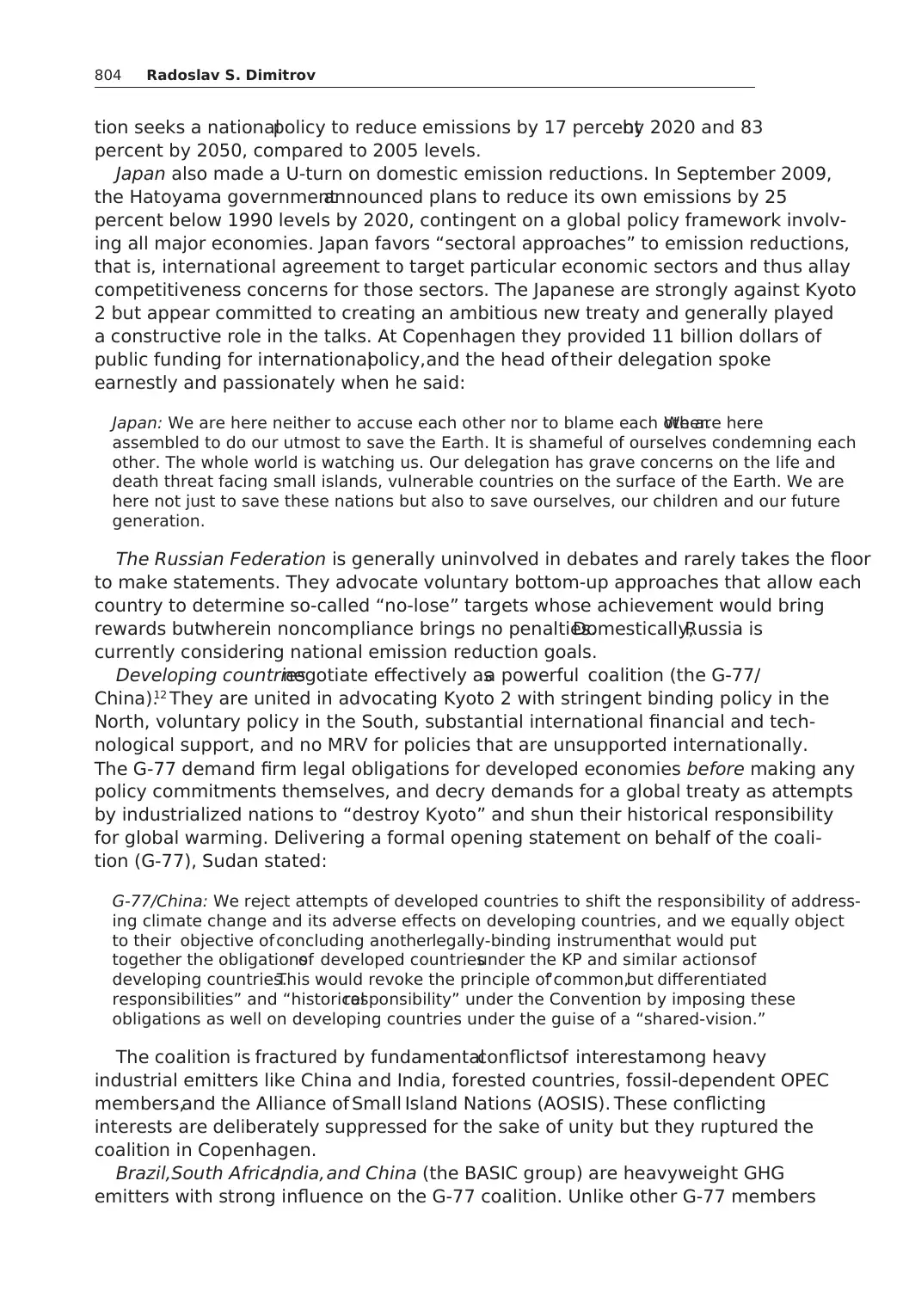
tion seeks a nationalpolicy to reduce emissions by 17 percentby 2020 and 83
percent by 2050, compared to 2005 levels.
Japan also made a U-turn on domestic emission reductions. In September 2009,
the Hatoyama governmentannounced plans to reduce its own emissions by 25
percent below 1990 levels by 2020, contingent on a global policy framework involv-
ing all major economies. Japan favors “sectoral approaches” to emission reductions,
that is, international agreement to target particular economic sectors and thus allay
competitiveness concerns for those sectors. The Japanese are strongly against Kyoto
2 but appear committed to creating an ambitious new treaty and generally played
a constructive role in the talks. At Copenhagen they provided 11 billion dollars of
public funding for internationalpolicy,and the head of their delegation spoke
earnestly and passionately when he said:
Japan: We are here neither to accuse each other nor to blame each other.We are here
assembled to do our utmost to save the Earth. It is shameful of ourselves condemning each
other. The whole world is watching us. Our delegation has grave concerns on the life and
death threat facing small islands, vulnerable countries on the surface of the Earth. We are
here not just to save these nations but also to save ourselves, our children and our future
generation.
The Russian Federation is generally uninvolved in debates and rarely takes the floor
to make statements. They advocate voluntary bottom-up approaches that allow each
country to determine so-called “no-lose” targets whose achievement would bring
rewards butwherein noncompliance brings no penalties.Domestically,Russia is
currently considering national emission reduction goals.
Developing countriesnegotiate effectively asa powerful coalition (the G-77/
China).12 They are united in advocating Kyoto 2 with stringent binding policy in the
North, voluntary policy in the South, substantial international financial and tech-
nological support, and no MRV for policies that are unsupported internationally.
The G-77 demand firm legal obligations for developed economies before making any
policy commitments themselves, and decry demands for a global treaty as attempts
by industrialized nations to “destroy Kyoto” and shun their historical responsibility
for global warming. Delivering a formal opening statement on behalf of the coali-
tion (G-77), Sudan stated:
G-77/China: We reject attempts of developed countries to shift the responsibility of address-
ing climate change and its adverse effects on developing countries, and we equally object
to their objective of concluding anotherlegally-binding instrumentthat would put
together the obligationsof developed countriesunder the KP and similar actionsof
developing countries.This would revoke the principle of“common,but differentiated
responsibilities” and “historicalresponsibility” under the Convention by imposing these
obligations as well on developing countries under the guise of a “shared-vision.”
The coalition is fractured by fundamentalconflictsof interestamong heavy
industrial emitters like China and India, forested countries, fossil-dependent OPEC
members,and the Alliance of Small Island Nations (AOSIS). These conflicting
interests are deliberately suppressed for the sake of unity but they ruptured the
coalition in Copenhagen.
Brazil,South Africa,India,and China (the BASIC group) are heavyweight GHG
emitters with strong influence on the G-77 coalition. Unlike other G-77 members
804 Radoslav S. Dimitrov
percent by 2050, compared to 2005 levels.
Japan also made a U-turn on domestic emission reductions. In September 2009,
the Hatoyama governmentannounced plans to reduce its own emissions by 25
percent below 1990 levels by 2020, contingent on a global policy framework involv-
ing all major economies. Japan favors “sectoral approaches” to emission reductions,
that is, international agreement to target particular economic sectors and thus allay
competitiveness concerns for those sectors. The Japanese are strongly against Kyoto
2 but appear committed to creating an ambitious new treaty and generally played
a constructive role in the talks. At Copenhagen they provided 11 billion dollars of
public funding for internationalpolicy,and the head of their delegation spoke
earnestly and passionately when he said:
Japan: We are here neither to accuse each other nor to blame each other.We are here
assembled to do our utmost to save the Earth. It is shameful of ourselves condemning each
other. The whole world is watching us. Our delegation has grave concerns on the life and
death threat facing small islands, vulnerable countries on the surface of the Earth. We are
here not just to save these nations but also to save ourselves, our children and our future
generation.
The Russian Federation is generally uninvolved in debates and rarely takes the floor
to make statements. They advocate voluntary bottom-up approaches that allow each
country to determine so-called “no-lose” targets whose achievement would bring
rewards butwherein noncompliance brings no penalties.Domestically,Russia is
currently considering national emission reduction goals.
Developing countriesnegotiate effectively asa powerful coalition (the G-77/
China).12 They are united in advocating Kyoto 2 with stringent binding policy in the
North, voluntary policy in the South, substantial international financial and tech-
nological support, and no MRV for policies that are unsupported internationally.
The G-77 demand firm legal obligations for developed economies before making any
policy commitments themselves, and decry demands for a global treaty as attempts
by industrialized nations to “destroy Kyoto” and shun their historical responsibility
for global warming. Delivering a formal opening statement on behalf of the coali-
tion (G-77), Sudan stated:
G-77/China: We reject attempts of developed countries to shift the responsibility of address-
ing climate change and its adverse effects on developing countries, and we equally object
to their objective of concluding anotherlegally-binding instrumentthat would put
together the obligationsof developed countriesunder the KP and similar actionsof
developing countries.This would revoke the principle of“common,but differentiated
responsibilities” and “historicalresponsibility” under the Convention by imposing these
obligations as well on developing countries under the guise of a “shared-vision.”
The coalition is fractured by fundamentalconflictsof interestamong heavy
industrial emitters like China and India, forested countries, fossil-dependent OPEC
members,and the Alliance of Small Island Nations (AOSIS). These conflicting
interests are deliberately suppressed for the sake of unity but they ruptured the
coalition in Copenhagen.
Brazil,South Africa,India,and China (the BASIC group) are heavyweight GHG
emitters with strong influence on the G-77 coalition. Unlike other G-77 members
804 Radoslav S. Dimitrov
Paraphrase This Document
Need a fresh take? Get an instant paraphrase of this document with our AI Paraphraser
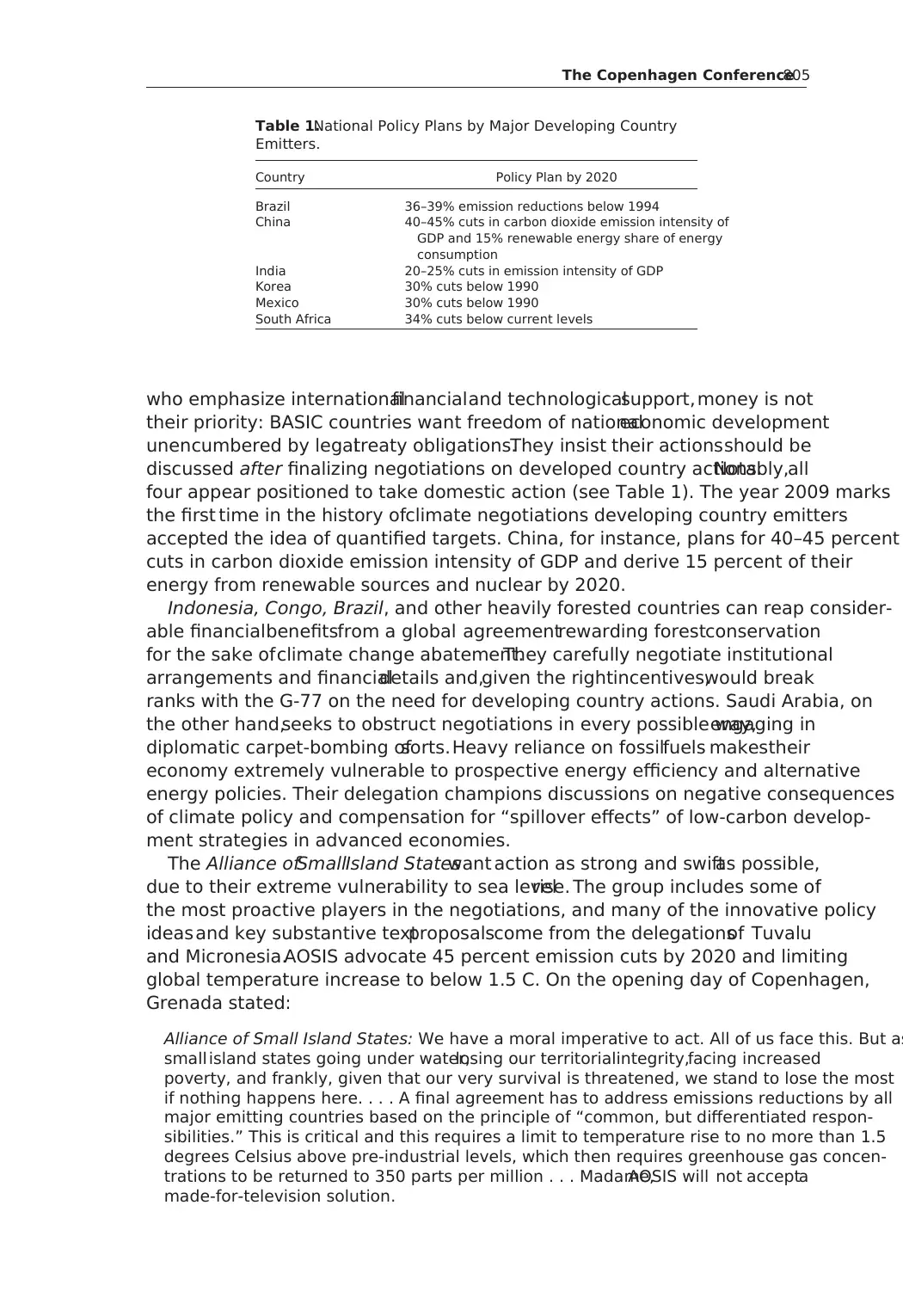
who emphasize internationalfinancialand technologicalsupport, money is not
their priority: BASIC countries want freedom of nationaleconomic development
unencumbered by legaltreaty obligations.They insist their actionsshould be
discussed after finalizing negotiations on developed country actions.Notably,all
four appear positioned to take domestic action (see Table 1). The year 2009 marks
the first time in the history ofclimate negotiations developing country emitters
accepted the idea of quantified targets. China, for instance, plans for 40–45 percent
cuts in carbon dioxide emission intensity of GDP and derive 15 percent of their
energy from renewable sources and nuclear by 2020.
Indonesia, Congo, Brazil, and other heavily forested countries can reap consider-
able financialbenefitsfrom a global agreementrewarding forestconservation
for the sake ofclimate change abatement.They carefully negotiate institutional
arrangements and financialdetails and,given the rightincentives,would break
ranks with the G-77 on the need for developing country actions. Saudi Arabia, on
the other hand,seeks to obstruct negotiations in every possible way,engaging in
diplomatic carpet-bombing ofsorts.Heavy reliance on fossilfuels makestheir
economy extremely vulnerable to prospective energy efficiency and alternative
energy policies. Their delegation champions discussions on negative consequences
of climate policy and compensation for “spillover effects” of low-carbon develop-
ment strategies in advanced economies.
The Alliance ofSmallIsland Stateswant action as strong and swiftas possible,
due to their extreme vulnerability to sea levelrise. The group includes some of
the most proactive players in the negotiations, and many of the innovative policy
ideasand key substantive textproposalscome from the delegationsof Tuvalu
and Micronesia.AOSIS advocate 45 percent emission cuts by 2020 and limiting
global temperature increase to below 1.5 C. On the opening day of Copenhagen,
Grenada stated:
Alliance of Small Island States: We have a moral imperative to act. All of us face this. But as
small island states going under water,losing our territorialintegrity,facing increased
poverty, and frankly, given that our very survival is threatened, we stand to lose the most
if nothing happens here. . . . A final agreement has to address emissions reductions by all
major emitting countries based on the principle of “common, but differentiated respon-
sibilities.” This is critical and this requires a limit to temperature rise to no more than 1.5
degrees Celsius above pre-industrial levels, which then requires greenhouse gas concen-
trations to be returned to 350 parts per million . . . Madame,AOSIS will not accepta
made-for-television solution.
Table 1.National Policy Plans by Major Developing Country
Emitters.
Country Policy Plan by 2020
Brazil 36–39% emission reductions below 1994
China 40–45% cuts in carbon dioxide emission intensity of
GDP and 15% renewable energy share of energy
consumption
India 20–25% cuts in emission intensity of GDP
Korea 30% cuts below 1990
Mexico 30% cuts below 1990
South Africa 34% cuts below current levels
The Copenhagen Conference805
their priority: BASIC countries want freedom of nationaleconomic development
unencumbered by legaltreaty obligations.They insist their actionsshould be
discussed after finalizing negotiations on developed country actions.Notably,all
four appear positioned to take domestic action (see Table 1). The year 2009 marks
the first time in the history ofclimate negotiations developing country emitters
accepted the idea of quantified targets. China, for instance, plans for 40–45 percent
cuts in carbon dioxide emission intensity of GDP and derive 15 percent of their
energy from renewable sources and nuclear by 2020.
Indonesia, Congo, Brazil, and other heavily forested countries can reap consider-
able financialbenefitsfrom a global agreementrewarding forestconservation
for the sake ofclimate change abatement.They carefully negotiate institutional
arrangements and financialdetails and,given the rightincentives,would break
ranks with the G-77 on the need for developing country actions. Saudi Arabia, on
the other hand,seeks to obstruct negotiations in every possible way,engaging in
diplomatic carpet-bombing ofsorts.Heavy reliance on fossilfuels makestheir
economy extremely vulnerable to prospective energy efficiency and alternative
energy policies. Their delegation champions discussions on negative consequences
of climate policy and compensation for “spillover effects” of low-carbon develop-
ment strategies in advanced economies.
The Alliance ofSmallIsland Stateswant action as strong and swiftas possible,
due to their extreme vulnerability to sea levelrise. The group includes some of
the most proactive players in the negotiations, and many of the innovative policy
ideasand key substantive textproposalscome from the delegationsof Tuvalu
and Micronesia.AOSIS advocate 45 percent emission cuts by 2020 and limiting
global temperature increase to below 1.5 C. On the opening day of Copenhagen,
Grenada stated:
Alliance of Small Island States: We have a moral imperative to act. All of us face this. But as
small island states going under water,losing our territorialintegrity,facing increased
poverty, and frankly, given that our very survival is threatened, we stand to lose the most
if nothing happens here. . . . A final agreement has to address emissions reductions by all
major emitting countries based on the principle of “common, but differentiated respon-
sibilities.” This is critical and this requires a limit to temperature rise to no more than 1.5
degrees Celsius above pre-industrial levels, which then requires greenhouse gas concen-
trations to be returned to 350 parts per million . . . Madame,AOSIS will not accepta
made-for-television solution.
Table 1.National Policy Plans by Major Developing Country
Emitters.
Country Policy Plan by 2020
Brazil 36–39% emission reductions below 1994
China 40–45% cuts in carbon dioxide emission intensity of
GDP and 15% renewable energy share of energy
consumption
India 20–25% cuts in emission intensity of GDP
Korea 30% cuts below 1990
Mexico 30% cuts below 1990
South Africa 34% cuts below current levels
The Copenhagen Conference805
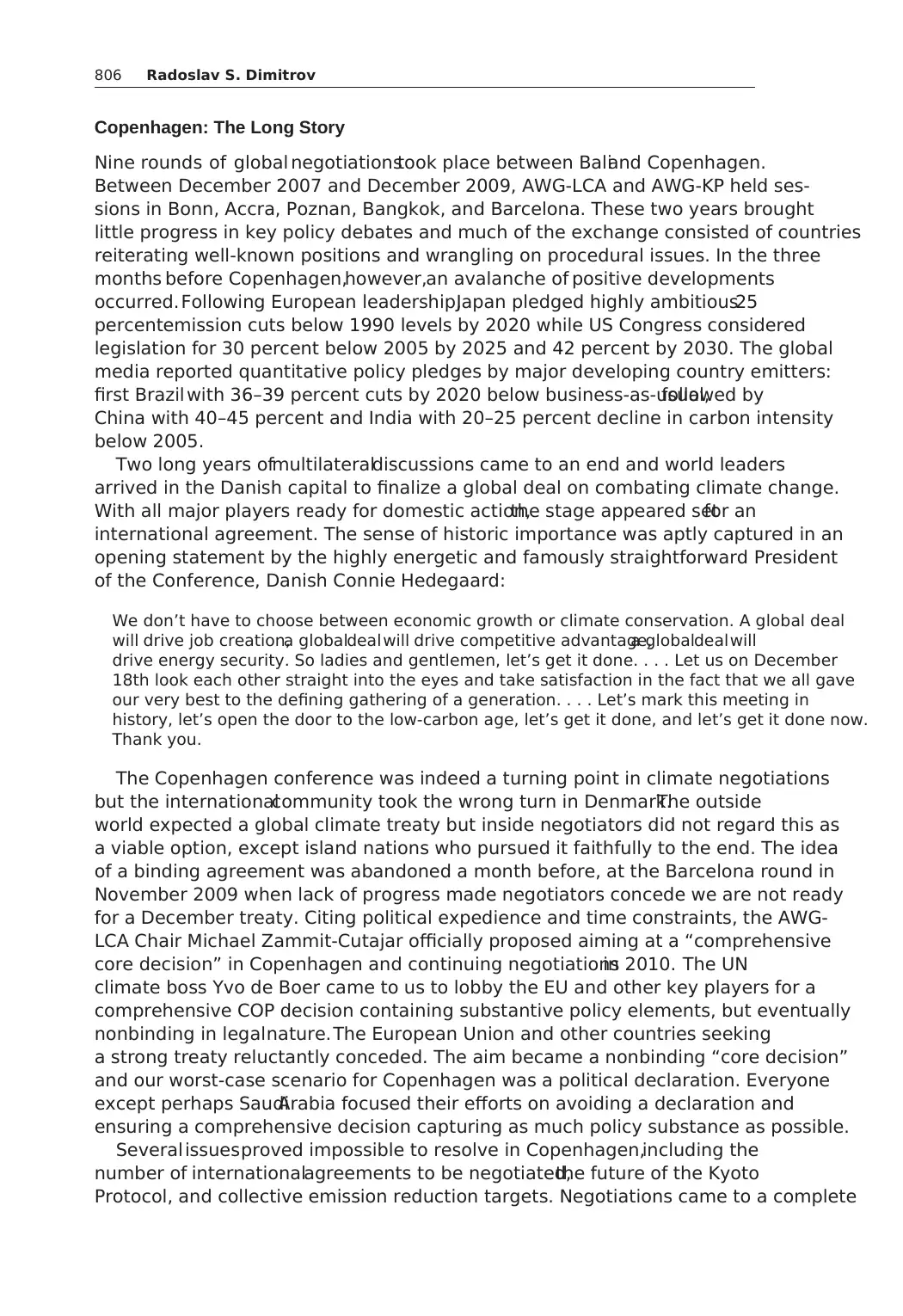
Copenhagen: The Long Story
Nine rounds of global negotiationstook place between Baliand Copenhagen.
Between December 2007 and December 2009, AWG-LCA and AWG-KP held ses-
sions in Bonn, Accra, Poznan, Bangkok, and Barcelona. These two years brought
little progress in key policy debates and much of the exchange consisted of countries
reiterating well-known positions and wrangling on procedural issues. In the three
months before Copenhagen,however,an avalanche of positive developments
occurred. Following European leadership,Japan pledged highly ambitious25
percentemission cuts below 1990 levels by 2020 while US Congress considered
legislation for 30 percent below 2005 by 2025 and 42 percent by 2030. The global
media reported quantitative policy pledges by major developing country emitters:
first Brazil with 36–39 percent cuts by 2020 below business-as-usual,followed by
China with 40–45 percent and India with 20–25 percent decline in carbon intensity
below 2005.
Two long years ofmultilateraldiscussions came to an end and world leaders
arrived in the Danish capital to finalize a global deal on combating climate change.
With all major players ready for domestic action,the stage appeared setfor an
international agreement. The sense of historic importance was aptly captured in an
opening statement by the highly energetic and famously straightforward President
of the Conference, Danish Connie Hedegaard:
We don’t have to choose between economic growth or climate conservation. A global deal
will drive job creation,a globaldealwill drive competitive advantage,a globaldealwill
drive energy security. So ladies and gentlemen, let’s get it done. . . . Let us on December
18th look each other straight into the eyes and take satisfaction in the fact that we all gave
our very best to the defining gathering of a generation. . . . Let’s mark this meeting in
history, let’s open the door to the low-carbon age, let’s get it done, and let’s get it done now.
Thank you.
The Copenhagen conference was indeed a turning point in climate negotiations
but the internationalcommunity took the wrong turn in Denmark.The outside
world expected a global climate treaty but inside negotiators did not regard this as
a viable option, except island nations who pursued it faithfully to the end. The idea
of a binding agreement was abandoned a month before, at the Barcelona round in
November 2009 when lack of progress made negotiators concede we are not ready
for a December treaty. Citing political expedience and time constraints, the AWG-
LCA Chair Michael Zammit-Cutajar officially proposed aiming at a “comprehensive
core decision” in Copenhagen and continuing negotiationsin 2010. The UN
climate boss Yvo de Boer came to us to lobby the EU and other key players for a
comprehensive COP decision containing substantive policy elements, but eventually
nonbinding in legalnature.The European Union and other countries seeking
a strong treaty reluctantly conceded. The aim became a nonbinding “core decision”
and our worst-case scenario for Copenhagen was a political declaration. Everyone
except perhaps SaudiArabia focused their efforts on avoiding a declaration and
ensuring a comprehensive decision capturing as much policy substance as possible.
Several issuesproved impossible to resolve in Copenhagen,including the
number of internationalagreements to be negotiated,the future of the Kyoto
Protocol, and collective emission reduction targets. Negotiations came to a complete
806 Radoslav S. Dimitrov
Nine rounds of global negotiationstook place between Baliand Copenhagen.
Between December 2007 and December 2009, AWG-LCA and AWG-KP held ses-
sions in Bonn, Accra, Poznan, Bangkok, and Barcelona. These two years brought
little progress in key policy debates and much of the exchange consisted of countries
reiterating well-known positions and wrangling on procedural issues. In the three
months before Copenhagen,however,an avalanche of positive developments
occurred. Following European leadership,Japan pledged highly ambitious25
percentemission cuts below 1990 levels by 2020 while US Congress considered
legislation for 30 percent below 2005 by 2025 and 42 percent by 2030. The global
media reported quantitative policy pledges by major developing country emitters:
first Brazil with 36–39 percent cuts by 2020 below business-as-usual,followed by
China with 40–45 percent and India with 20–25 percent decline in carbon intensity
below 2005.
Two long years ofmultilateraldiscussions came to an end and world leaders
arrived in the Danish capital to finalize a global deal on combating climate change.
With all major players ready for domestic action,the stage appeared setfor an
international agreement. The sense of historic importance was aptly captured in an
opening statement by the highly energetic and famously straightforward President
of the Conference, Danish Connie Hedegaard:
We don’t have to choose between economic growth or climate conservation. A global deal
will drive job creation,a globaldealwill drive competitive advantage,a globaldealwill
drive energy security. So ladies and gentlemen, let’s get it done. . . . Let us on December
18th look each other straight into the eyes and take satisfaction in the fact that we all gave
our very best to the defining gathering of a generation. . . . Let’s mark this meeting in
history, let’s open the door to the low-carbon age, let’s get it done, and let’s get it done now.
Thank you.
The Copenhagen conference was indeed a turning point in climate negotiations
but the internationalcommunity took the wrong turn in Denmark.The outside
world expected a global climate treaty but inside negotiators did not regard this as
a viable option, except island nations who pursued it faithfully to the end. The idea
of a binding agreement was abandoned a month before, at the Barcelona round in
November 2009 when lack of progress made negotiators concede we are not ready
for a December treaty. Citing political expedience and time constraints, the AWG-
LCA Chair Michael Zammit-Cutajar officially proposed aiming at a “comprehensive
core decision” in Copenhagen and continuing negotiationsin 2010. The UN
climate boss Yvo de Boer came to us to lobby the EU and other key players for a
comprehensive COP decision containing substantive policy elements, but eventually
nonbinding in legalnature.The European Union and other countries seeking
a strong treaty reluctantly conceded. The aim became a nonbinding “core decision”
and our worst-case scenario for Copenhagen was a political declaration. Everyone
except perhaps SaudiArabia focused their efforts on avoiding a declaration and
ensuring a comprehensive decision capturing as much policy substance as possible.
Several issuesproved impossible to resolve in Copenhagen,including the
number of internationalagreements to be negotiated,the future of the Kyoto
Protocol, and collective emission reduction targets. Negotiations came to a complete
806 Radoslav S. Dimitrov
⊘ This is a preview!⊘
Do you want full access?
Subscribe today to unlock all pages.

Trusted by 1+ million students worldwide
1 out of 27
Your All-in-One AI-Powered Toolkit for Academic Success.
+13062052269
info@desklib.com
Available 24*7 on WhatsApp / Email
![[object Object]](/_next/static/media/star-bottom.7253800d.svg)
Unlock your academic potential
Copyright © 2020–2025 A2Z Services. All Rights Reserved. Developed and managed by ZUCOL.
